A simple yet delicious dish of tender shrimp and pasta coated in a tomato sauce of bell peppers, onion, and scotch bonnet pepper, spiced with Caribbean adobo seasoning and fresh thyme and parsley and finished with a splash of lime juice for the best spicy shrimp pasta.
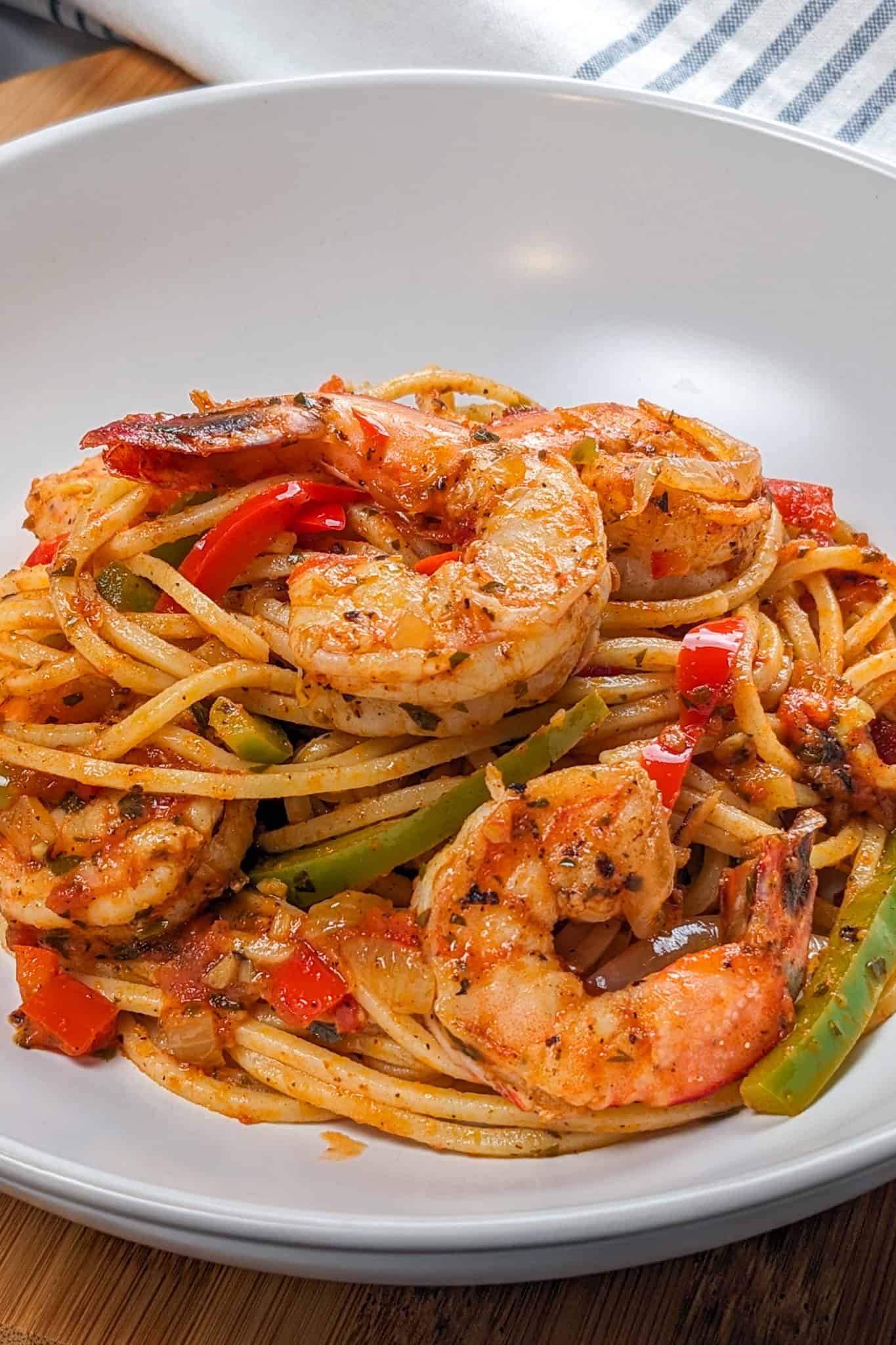
Table of Contents
Jump to:
- Flavors of the Caribbean
- Haitian Spaghetti
- Haitian Cuisine Global Recognition
- The West African Connection
- Scotch Bonnet Pepper Rich History
- Ingredients with Steps
- Culinary Glossary
- Instructions with Pictures
- How to Slice Scotch Bonnet Peppers
- Substitutions
- Variations
- Equipment
- Storage
- Cooking Tips
- Frequently Asked Questions
- Haitian-Inspired Recipes
- Seafood Recipes
- 📖 Recipe
- Subscribe to My YouTube Channel
- Have a Comment or Question?
Flavors of the Caribbean
Healthy Haitian-Style Creole Spicy Shrimp Pasta is a simple yet delicious pasta recipe that captures the vibrant flavors of the Caribbean. This dish features juicy shrimp and pasta coated in a spicy tomato sauce with bell peppers, onions, and scotch bonnet pepper, perfectly spiced with Caribbean adobo seasoning, fresh thyme, and parsley.
Finished with a splash of lime juice, this flavorful dish is a restaurant-quality dinner recipe that's ideal for weeknight meals or special occasions. With its blend of spices and heat, this pasta dish embodies the essence of Creole cooking, bringing a taste of the islands to your kitchen.
Haitian Spaghetti
Traditional Haitian spaghetti is a beloved classic often made with hot dogs and served with boiled eggs for breakfast. This dish is deeply rooted in my childhood memories, capturing the flavors and nostalgia of home.

Haitian spaghetti is called "espageti" in Haitian Creole. Learn how to make Haitian Shrimp "Espageti"!
Haitian spaghetti traditionally uses Haitian epis, a flavorful seasoning blend made with green onions, garlic, parsley, bell peppers, and herbs. The Dominican Republic has a similar dish, showcasing the strong cultural ties and shared culinary heritage between Haiti and its neighbor. This connection highlights the deep bond and shared history on the island of Hispaniola.

Epis - A traditional Haitian seasoning base made with green onions, garlic, parsley, bell peppers, and herbs, used to flavor many dishes. Learn how to make Epis.
Haiti was the first nation to have free black slaves, emphasizing the importance and the need for peace and unity between the two countries.
Haitian Cuisine Global Recognition
Haitian cuisine is a rich tapestry of flavors and influences, blending African, French, Spanish, and Taino culinary traditions. Its origins can be traced back to the island's history of colonization and slavery, with each cultural influence contributing to the vibrant and diverse dishes that define Haitian cooking today.
Known for its bold flavors and use of fresh herbs and spices, Haitian cuisine has gained popularity in urban areas like Miami and Brooklyn, as well as across the US in Portland and around the world like the UK. This global recognition has introduced many to the unique and delicious dishes that are a hallmark of Haiti's culinary heritage.

Looking for authentic Haitian recipes? Check out Love for Haitian Food and Savory Thoughts.
The West African Connection
West African cooking techniques have significantly influenced tomato-based dishes, particularly those that combine red bell peppers, tomatoes, onions, garlic, scotch bonnet pepper, and various spices. These ingredients form the backbone of many West African stews and sauces, known for their rich, complex flavors and vibrant colors.
I learned about this connection through Yewande Komolafe's "My Everyday Lagos" cookbook, specifically, her recipes for Ata Gige and Ata Lilo, showcasing how these elements combine to create deeply flavorful dishes.
My Rating: ⭐⭐⭐⭐⭐
My Review: One of my favorite Nigerian chefs and cookbooks has been an incredible guide on my journey to connect with my roots—especially since finding out I’m about 17% Nigerian. I’ve always been curious to learn more about my ancestors, and this book was the perfect entry point. It’s written in a way that’s super approachable and easy to understand from an American point of view, which made diving into Nigerian cooking feel natural and exciting. To this day, I still use many of the recipes, especially the Ata Gige—it’s bold, flavorful, and reminds me so much of Haitian Epis, which I truly believe has its roots in this blend. This book has become a meaningful staple in both my kitchen and my cultural journey.
Discovering that I have 20% Nigerian ancestry has heightened my curiosity about the culinary links between Haiti and the original home of my ancestors, Nigeria, inspiring me to explore and celebrate these shared flavors and techniques in my cooking.

Looking for authentic Nigerian recipes? Check out Chef Lola's Kitchen and Sisi Jemimah.
Scotch Bonnet Pepper Rich History
The scotch bonnet pepper is a small, fiery chili with a rich history and origin in the Caribbean. Known for its fruity flavor and intense heat, it is widely used in African and Afro-Caribbean cuisine, adding depth and spice to dishes.
This pepper is a staple in Creole and Jamaican cooking, often found in sauces, marinades, and street vendor offerings. Its influence is evident in the spicy tomato sauce of this recipe, where it brings a bold, vibrant heat that enhances the overall flavor profile of the dish. Learn more about Chili Peppers here.
More Delicious Recipes for Dinner
- Seared Snapper Spicy Creole Sauce and Roasted Vegetables (Popular on Instagram)
- Shrimp Farro Risotto with Mushrooms and Peas
- Best Spicy Sauteed Chili Lemon Garlic Shrimp and Vegetables
- Jalapeño Pesto and Argentinian Shrimp Pasta (Trending)
- Creole Shrimp and White Cheddar Cheese Risotto (Popular on Instagram)
- Cajun Shrimp Rice Bowl with Lemon Remoulade
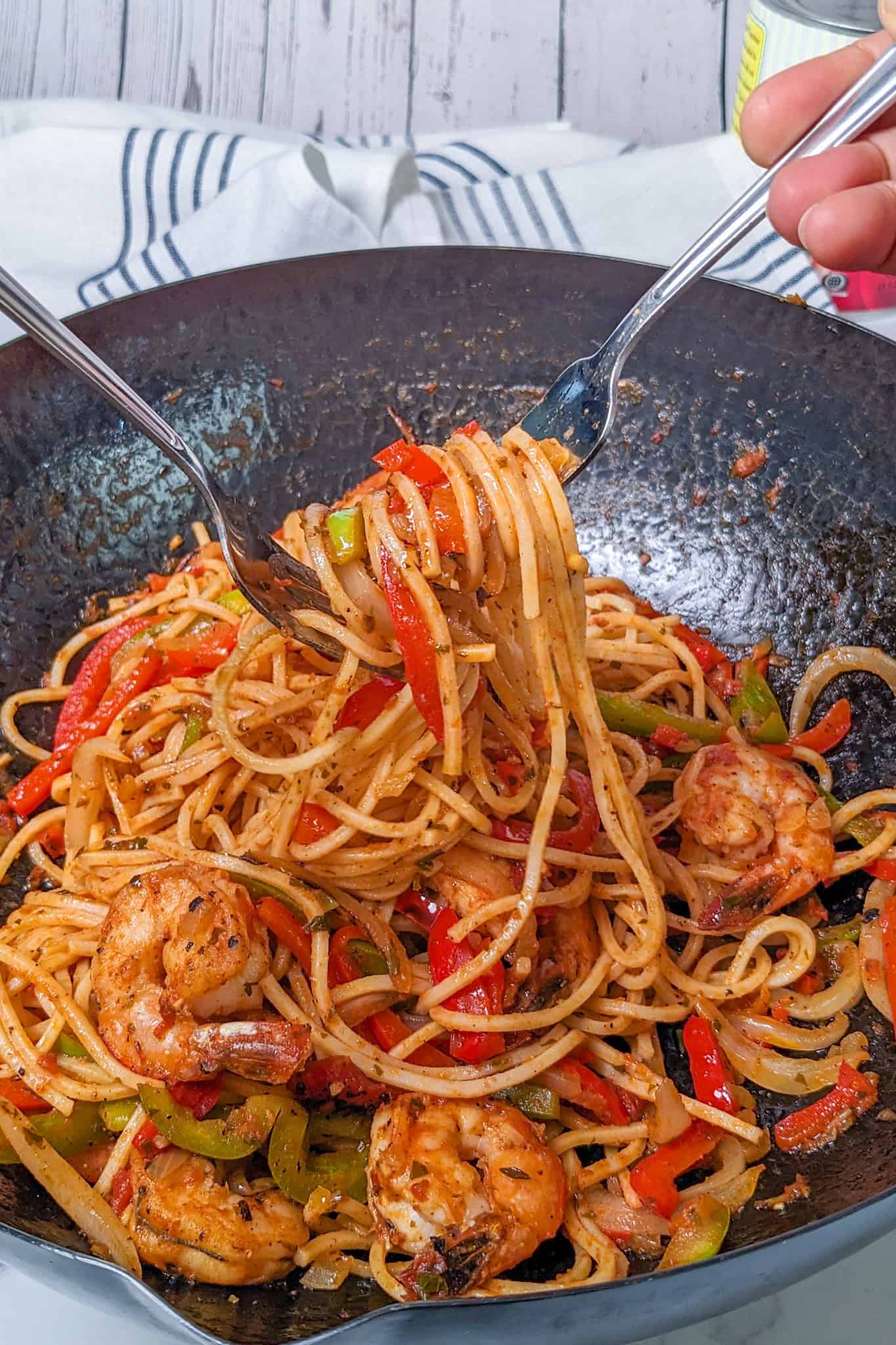
Ingredients with Steps
To prepare the sauce, heat olive oil over medium heat in a large saucepan, then add minced garlic and chopped onions, sautéing until fragrant and translucent. Stir in thyme, ground cloves, parsley, finely chopped bell pepper, scotch bonnet pepper, adobo seasoning, salt, and black pepper, cooking until the vegetables are softened.
Add crushed fire-roasted tomatoes and chicken broth, bringing the mixture to a simmer for 15-20 minutes until it thickens slightly. While the sauce simmers, cook the spaghetti according to package instructions until al dente, then drain, spread on a sheet pan, mix with olive oil, and let cool.
For the shrimp and vegetables, season the shrimp with salt and pepper, then sear in a hot skillet with olive oil. Remove the shrimp, add sliced white onion and bell peppers, and cook until slightly translucent. Return the shrimp to the pan with lime juice and a ladle of Creole sauce, simmering until the shrimp turn pink and opaque.
Finally, combine the cooked pasta with the shrimp sauce, tossing until everything is well mixed and coated.
Culinary Glossary
This section provides concise definitions of key ingredients and techniques to enhance understanding and improve cooking skills related to this recipe.
- Adobo Seasoning - A spice blend made with garlic, onion, paprika, oregano, and other spices, commonly used in Caribbean and Latin American cuisines.
- Thyme - Thyme is commonly used in Haitian cuisine as a key herb for seasoning meats, stews, and soups, reflecting the influence of French culinary traditions.
- Ground Clove - This is used in many Haitian dishes for its warm, aromatic, and slightly sweet flavor, which enhances the depth and complexity of traditional stews, rice dishes, and marinades.
- Scotch Bonnet Pepper - A small, hot chili pepper with a fruity flavor commonly used in Caribbean cooking.
- Crushed Fire-Roasted Tomatoes - Crushed fire-roasted tomatoes are used to speed up the cooking process by eliminating the need for additional preparation, while their natural smoky flavor provides a rich depth that replaces the traditional tomato paste typically used in Haitian dishes.
See the recipe card for quantities below.
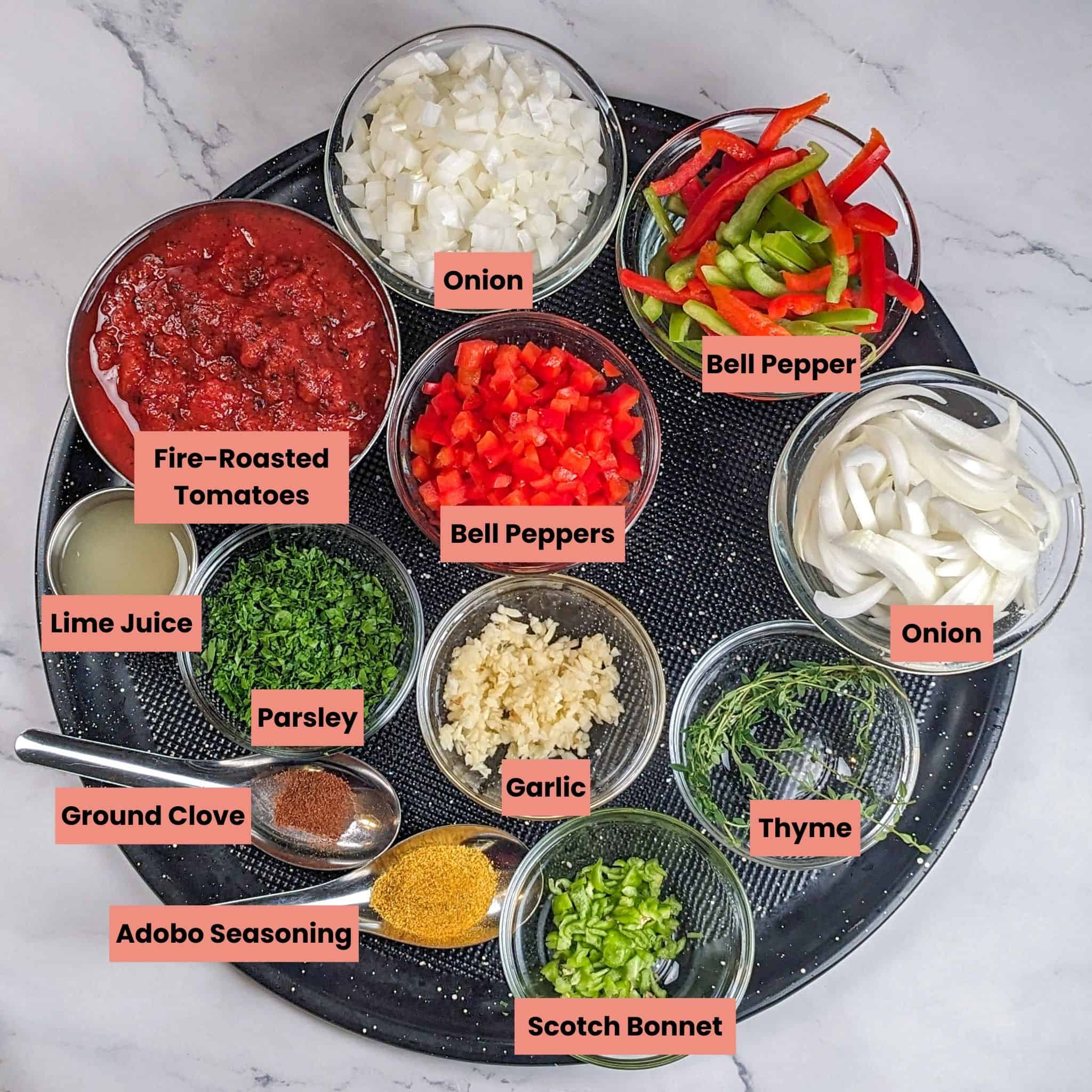
Learn about prepping sweet peppers.
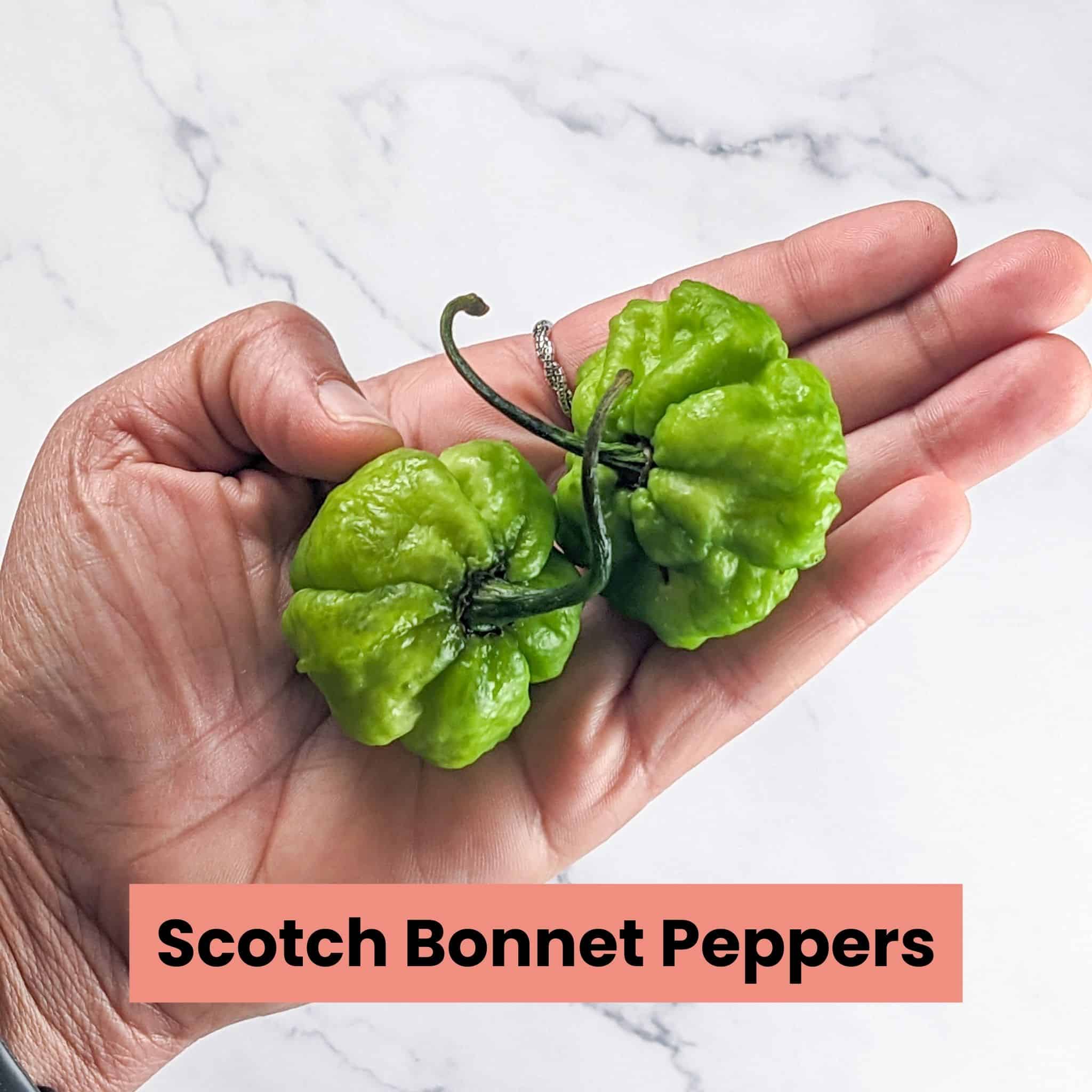
Learn How to Prep Hot Chili Peppers and/or About the Scoville Scale.
Instructions with Pictures
Follow the instructions and cooking tips below using the step-by-step picture guide.
Cook the Pasta
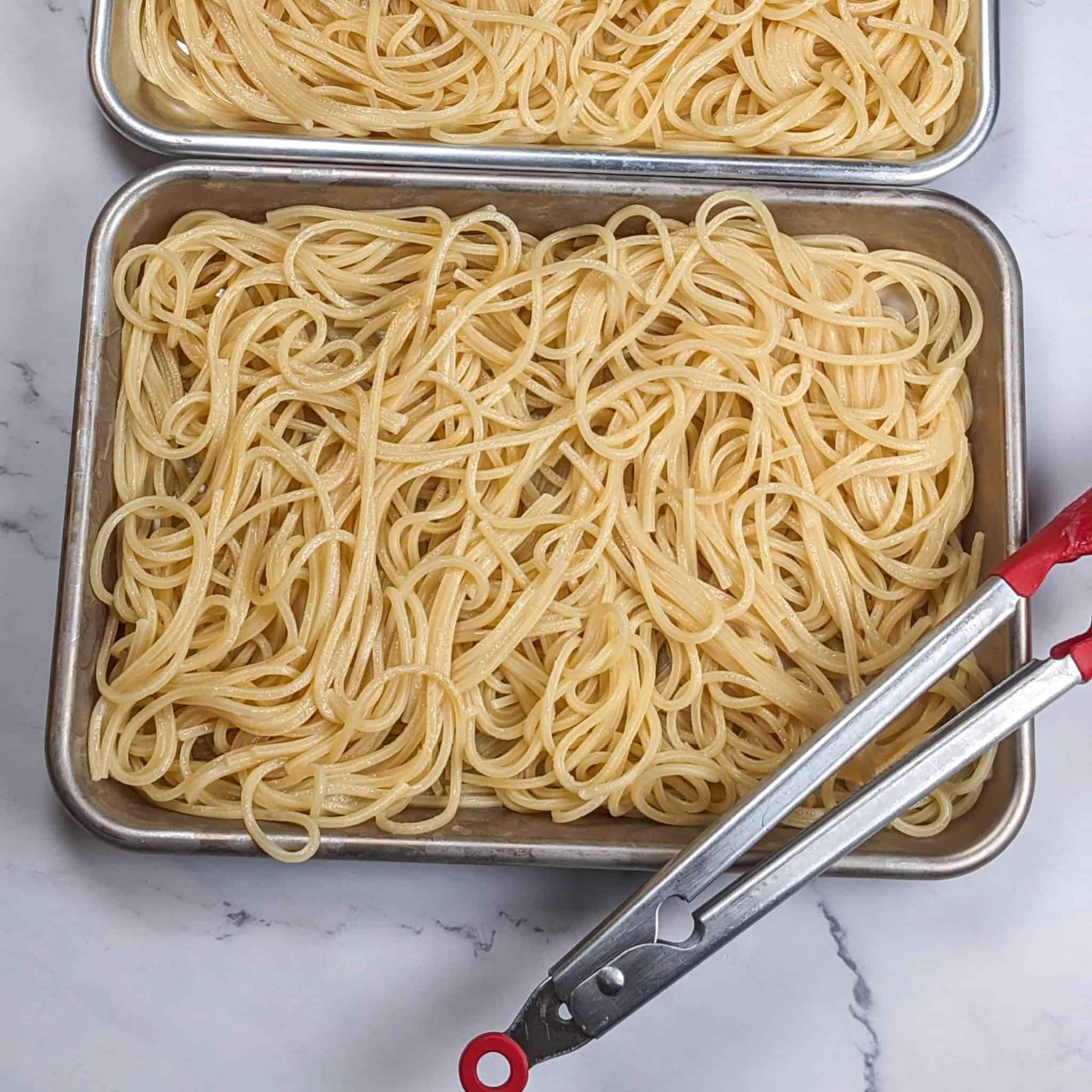
To cool the pasta, drain it and lid it on a sheet pan, tossing it with olive oil to prevent sticking. You do not want to rinse the pasta; you need to starch to allow the sauce to adhere and thicken.
Make the Pasta Sauce
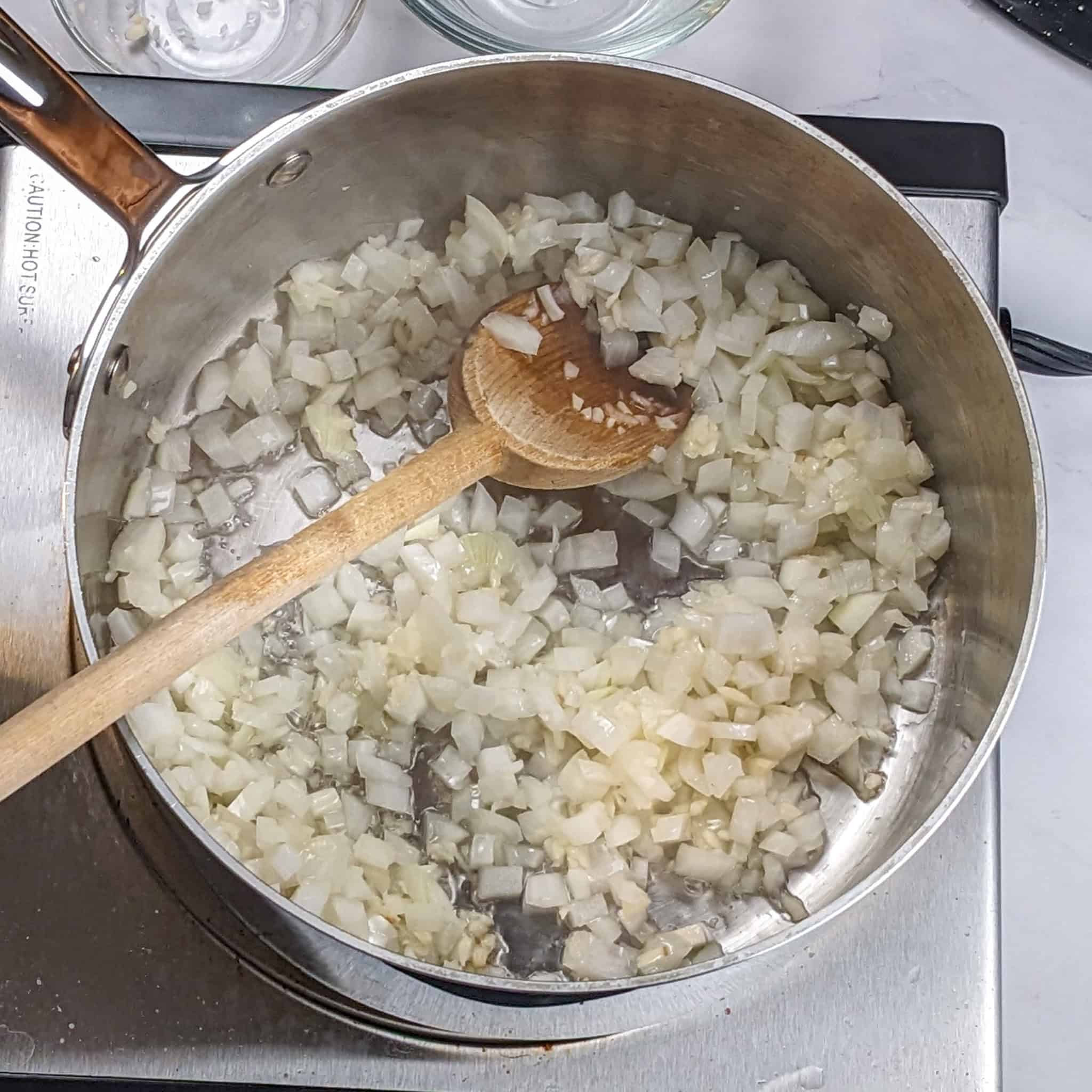
A good sauce base always starts with aromatics such as onion and garlic; ginger or green scallions are also used in dishes from other cultures.
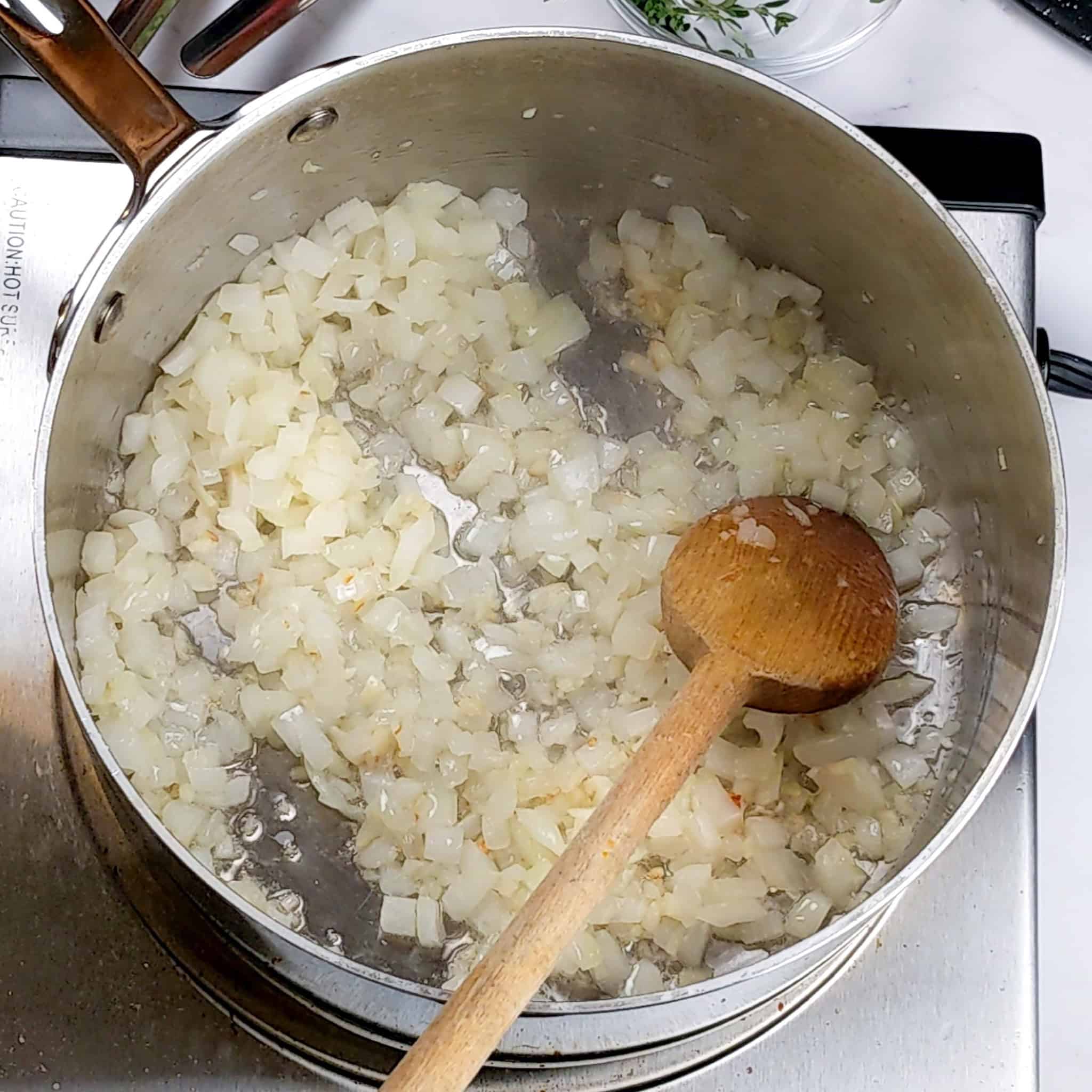
Saute the chopped onion and garlic until translucent and fragrant.
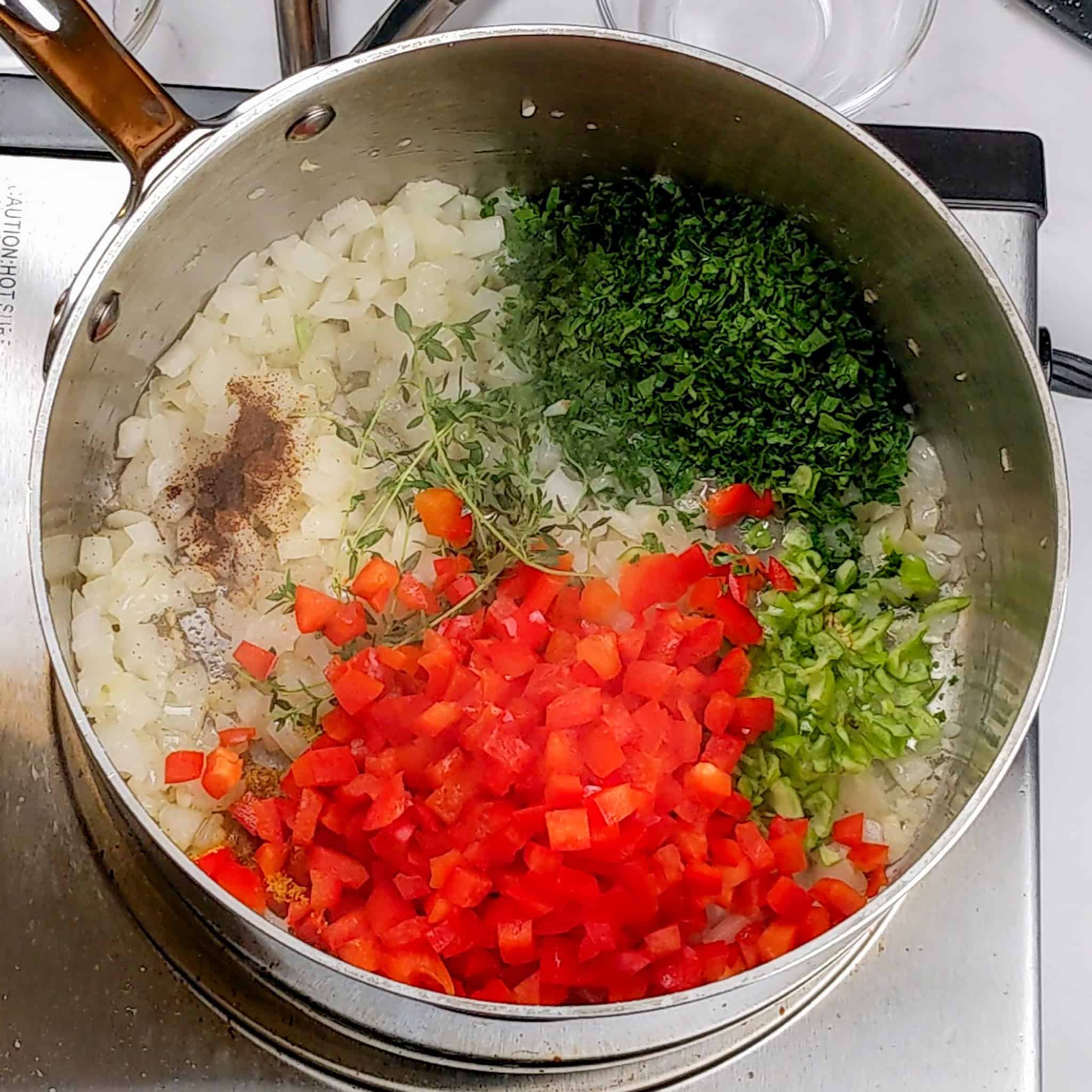
The sauce base is made differently from the traditional Haitian recipe steps. Usually, eipis is added at this point.
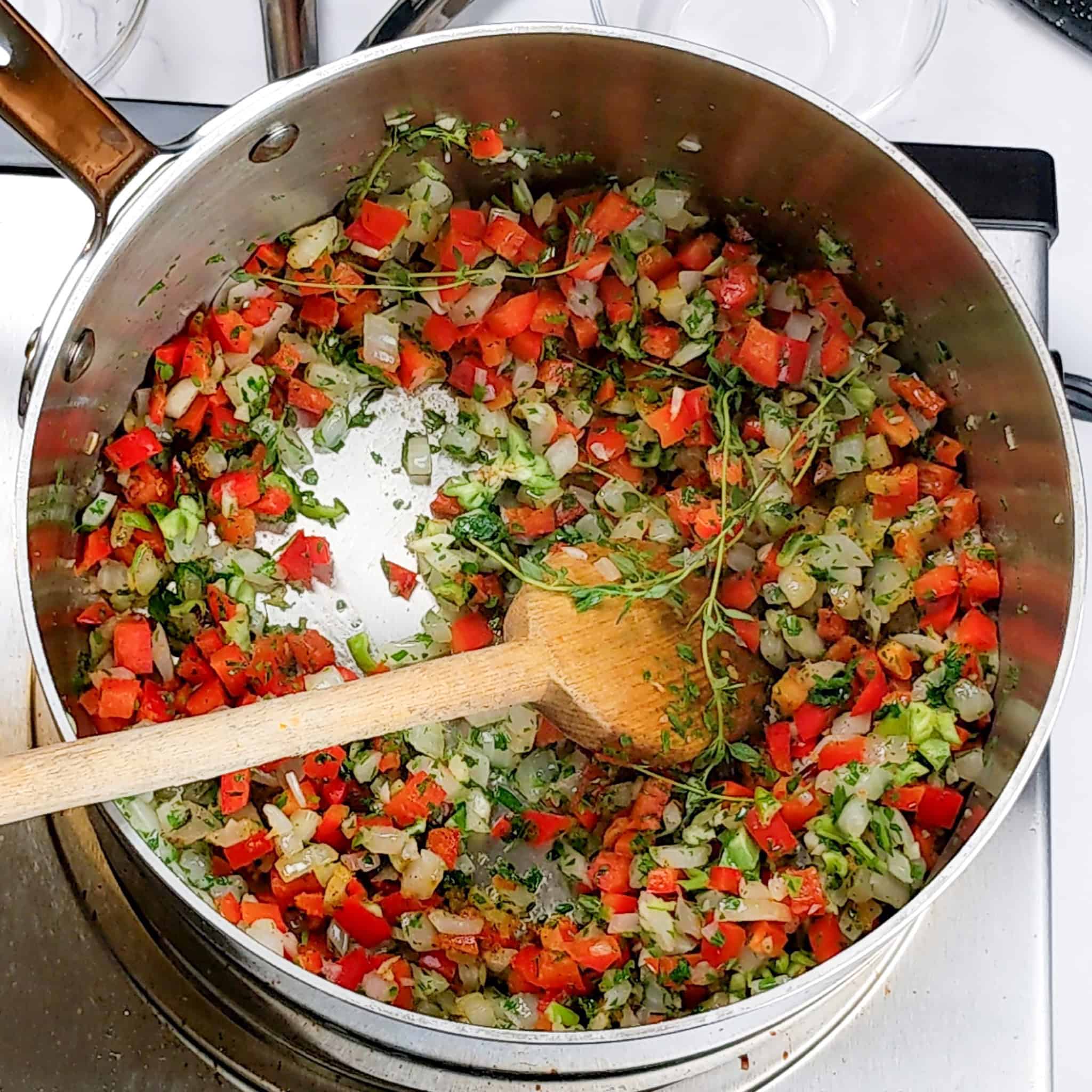
But for those who do not use it on a daily basis, this is a perfect way to make it similar to that without having to make a big batch.
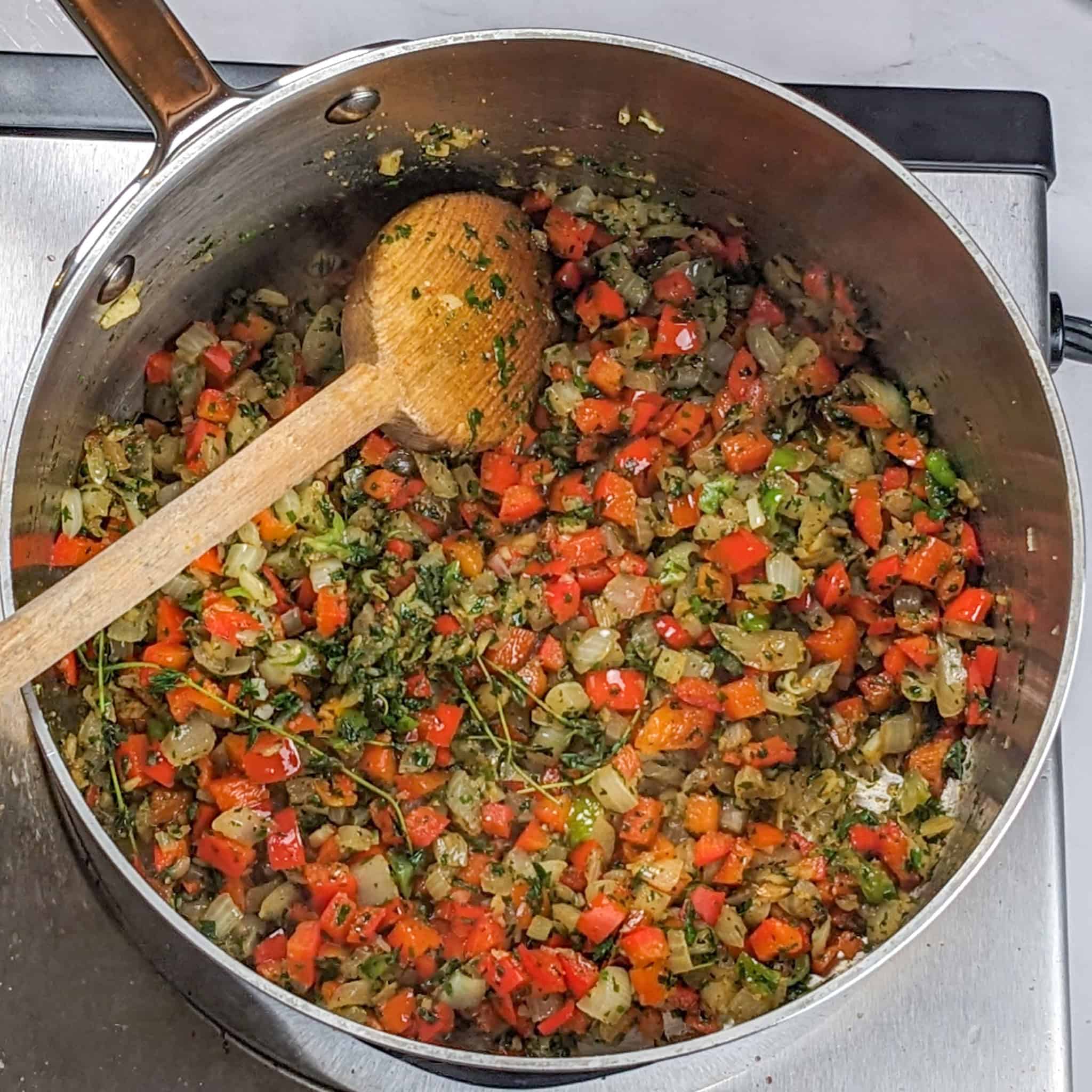
The vegetables are cooked until they are tender.
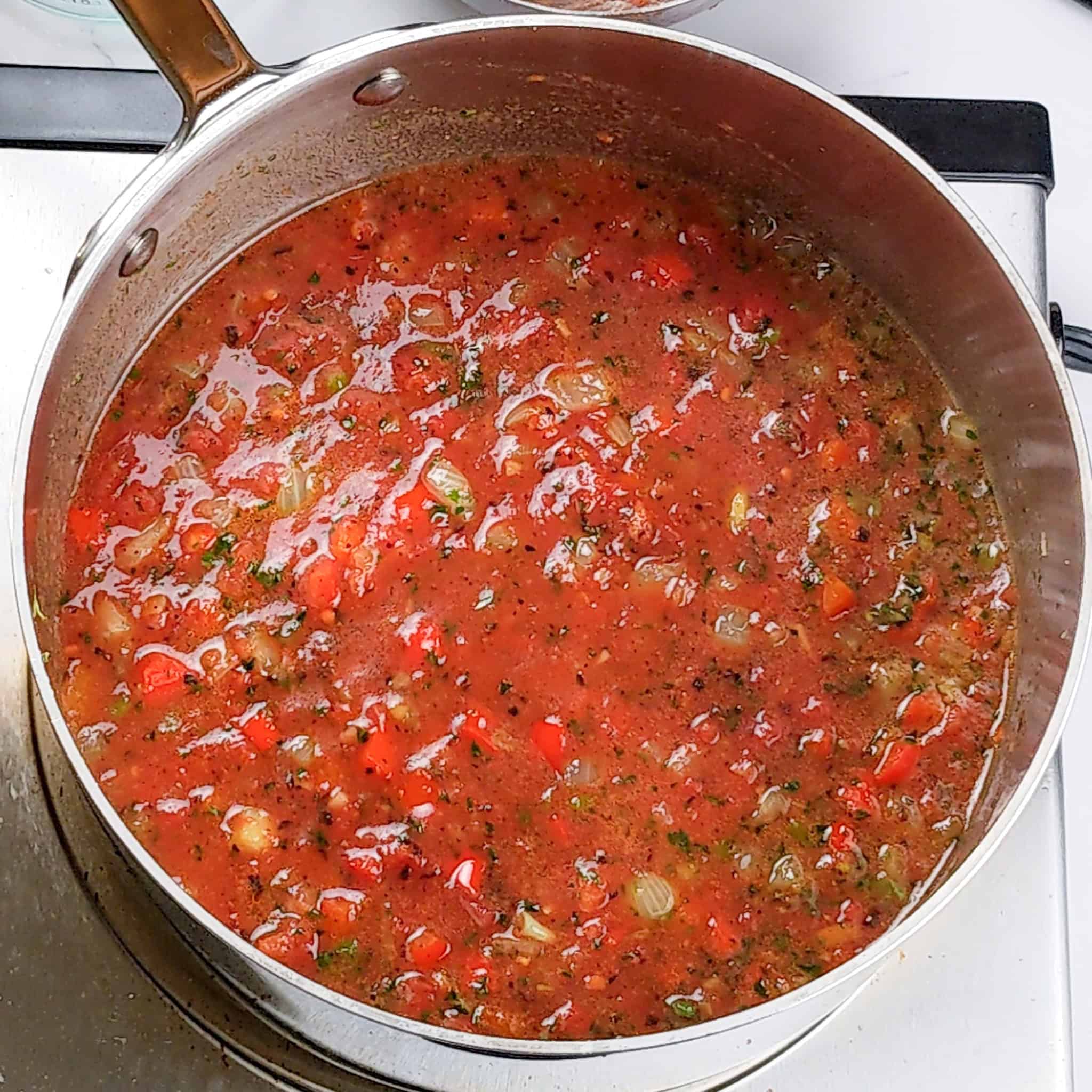
At this point, taste the crushed tomato sauce before it reduces to get a good idea of what to look for when it is done.
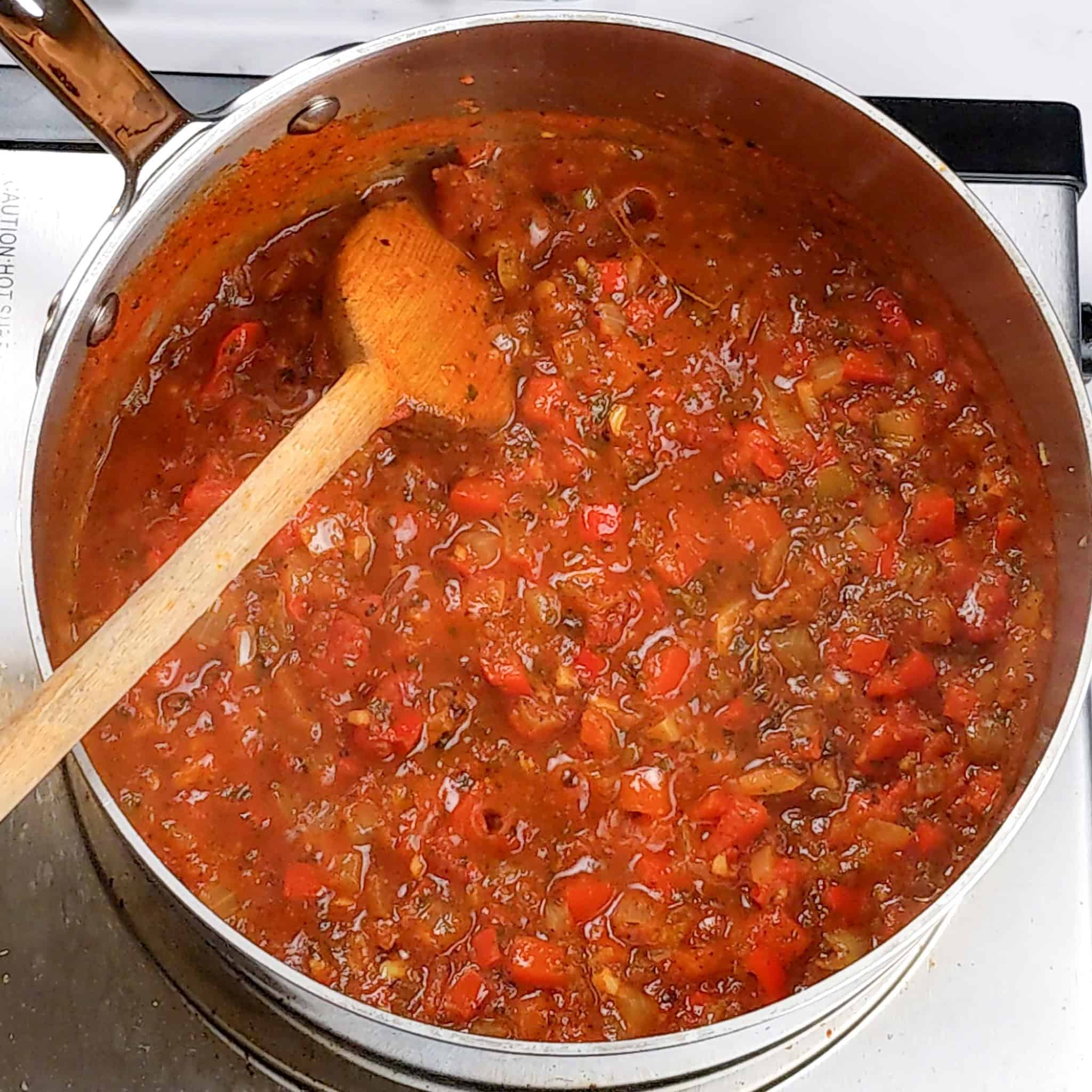
The tomato sauce is ready when all the vegetables are tender, has a slightly darker red color, and has thickened with a balance of acidity and sweetness.
My Rating: ⭐⭐⭐⭐⭐
Purchased: 06/06/23
My Review: As a chef with over two decades of experience relying on All-Clad, their D3 Stainless 3-quart saucepan is a kitchen workhorse. The sturdy 3-ply construction ensures even heat distribution for perfect simmering, searing, and everything in between. It's a breeze to clean, goes effortlessly from stovetop to oven, and consistently delivers exceptional results for rice, soups, sauces, and more. This saucepan is a worthy investment if you're looking for durable, versatile, and American-made cookware.

Cook the Shrimp and Vegetables
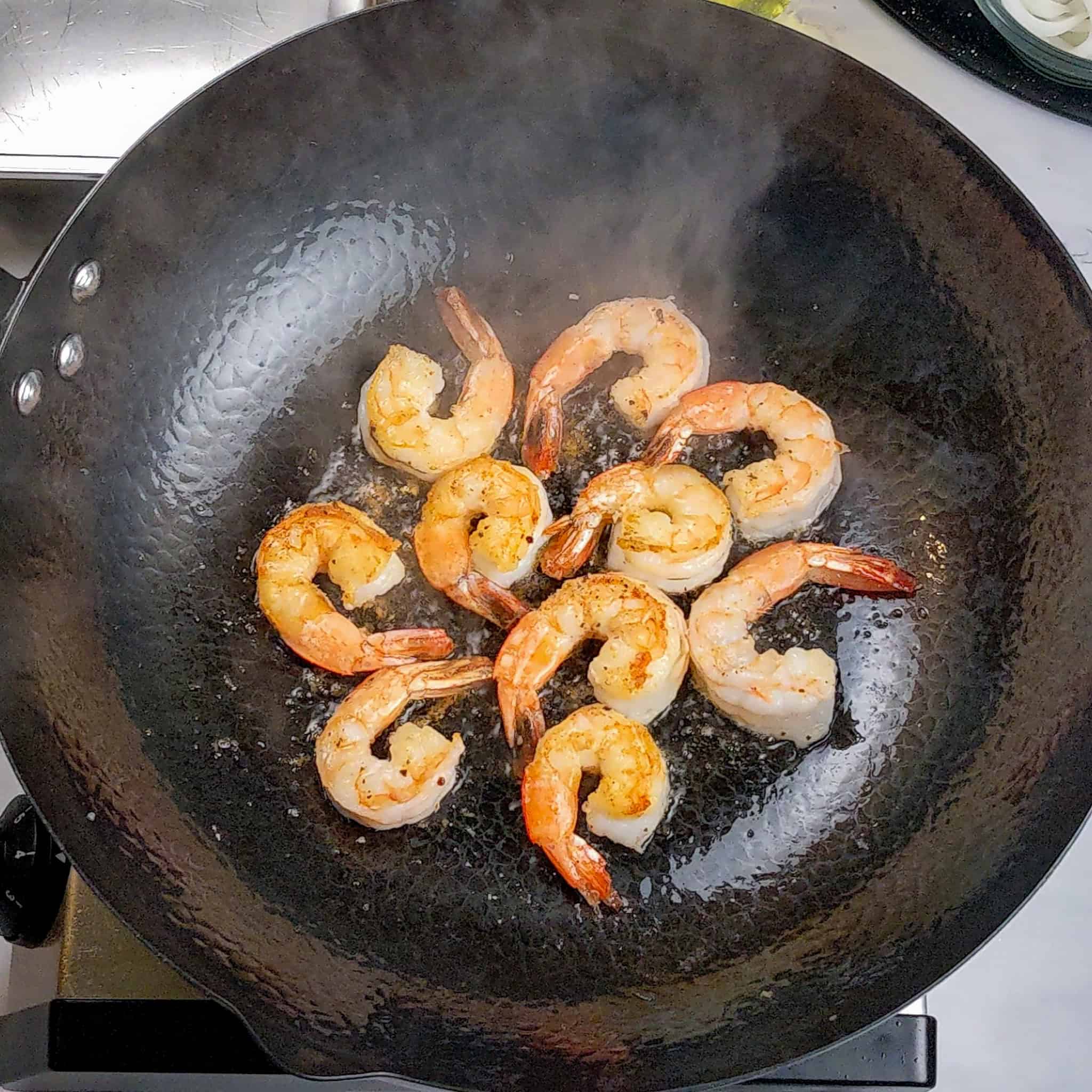
Make sure the wok is hot and ready before adding the oil. Then, add the shrimp after the oil has heated up. Do not overcrowd; this will prevent the shrimp from browning.

Stir-frying is a fast-paced cooking technique, so make sure you have everything prepped and ready to use.
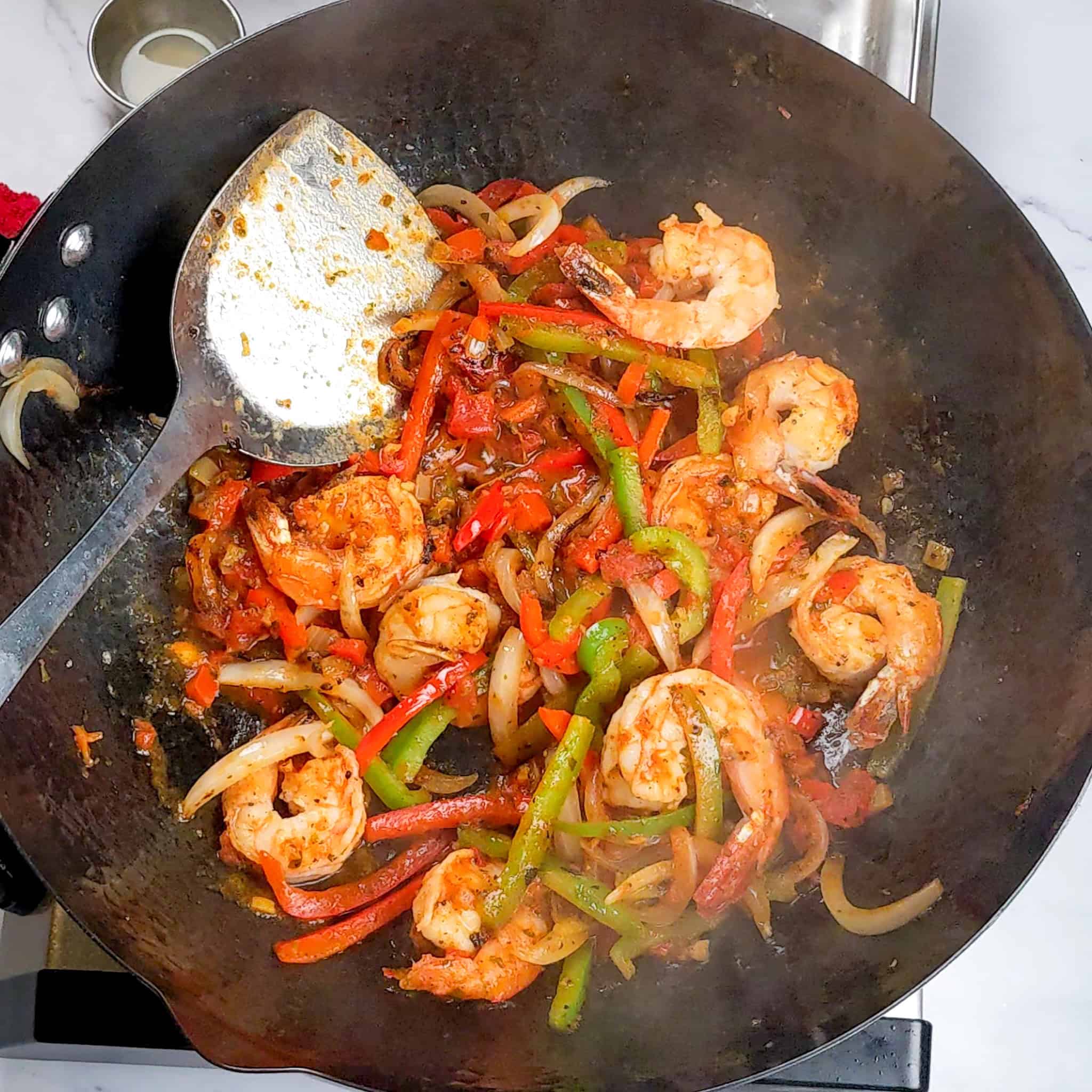
The tomato sauce shrimp can be kept separate until ready to cook.
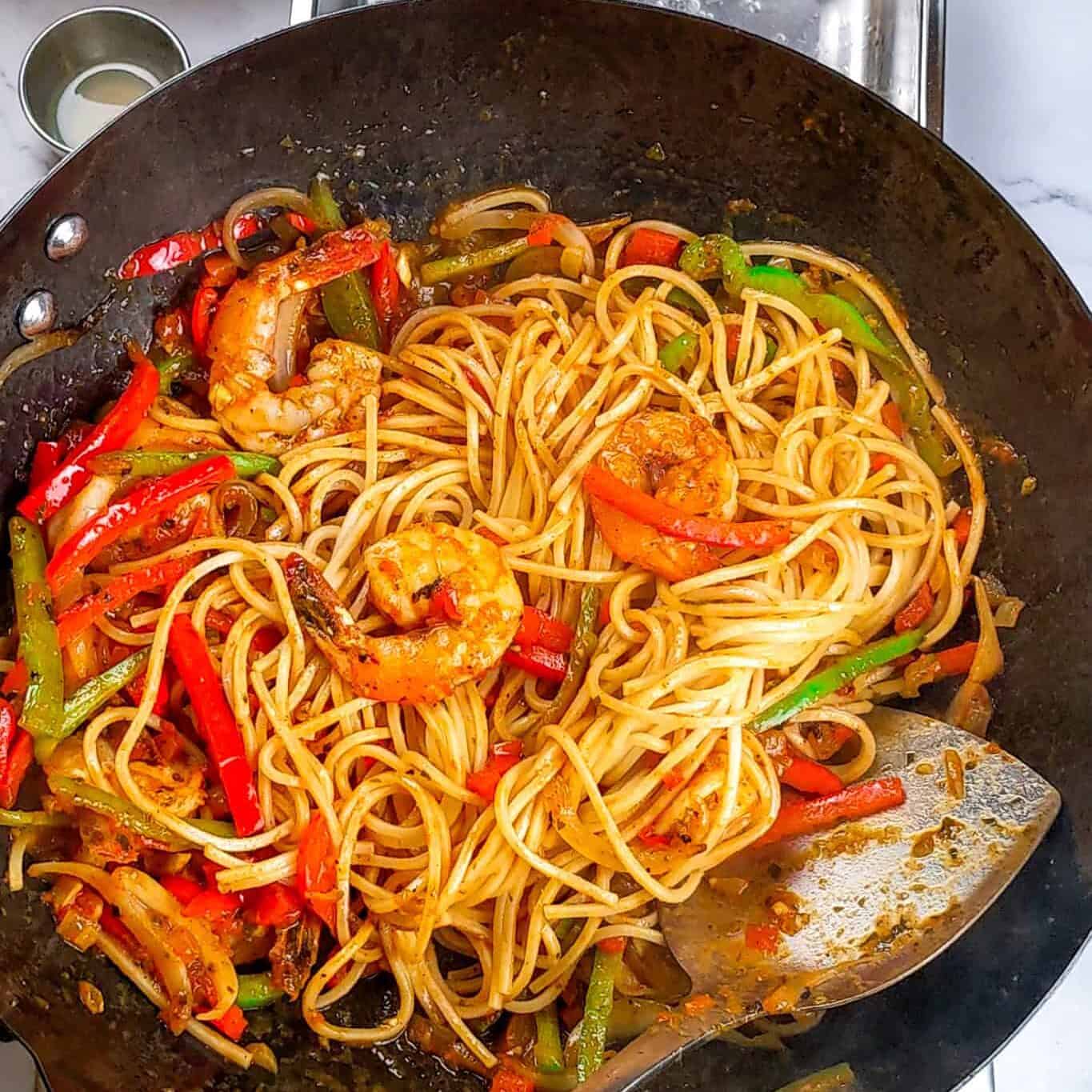
For this recipe, if using a wok, only cook two servings at a time to prevent overcrowding, which can cause uneven cooking.
My Rating: ⭐⭐⭐⭐⭐
Purchased: July 12, 2022
My Review: The BIELMEIER 12.5" Carbon Steel Wok is hands down my favorite wok to cook with. The size is perfect—not too big, not too small—and the flat bottom makes it super easy to use on any stovetop, especially for stir-fries and high-heat cooking. I was also impressed by the thoughtful design and the sleek packaging, which honestly makes it a great gift for anyone who loves to cook. What really stood out was the thorough set of instructions included on how to season and care for the wok—perfect for novice wok users who might feel intimidated. It’s a beautiful, functional piece that’s earned its permanent spot in my kitchen. Read my article on how to use a wok here.
How to Slice Scotch Bonnet Peppers
Scotch bonnet peppers are extremely hot, so it's crucial to wear gloves when prepping them to avoid skin irritation; follow the step-by-step instructions with pictures below to efficiently and safely prepare them.
Contrary to belief, seeds do not carry all the heat of the pepper; most of the heat is kept in the pith (white flesh). Learn more about Prepping Chili Peppers.
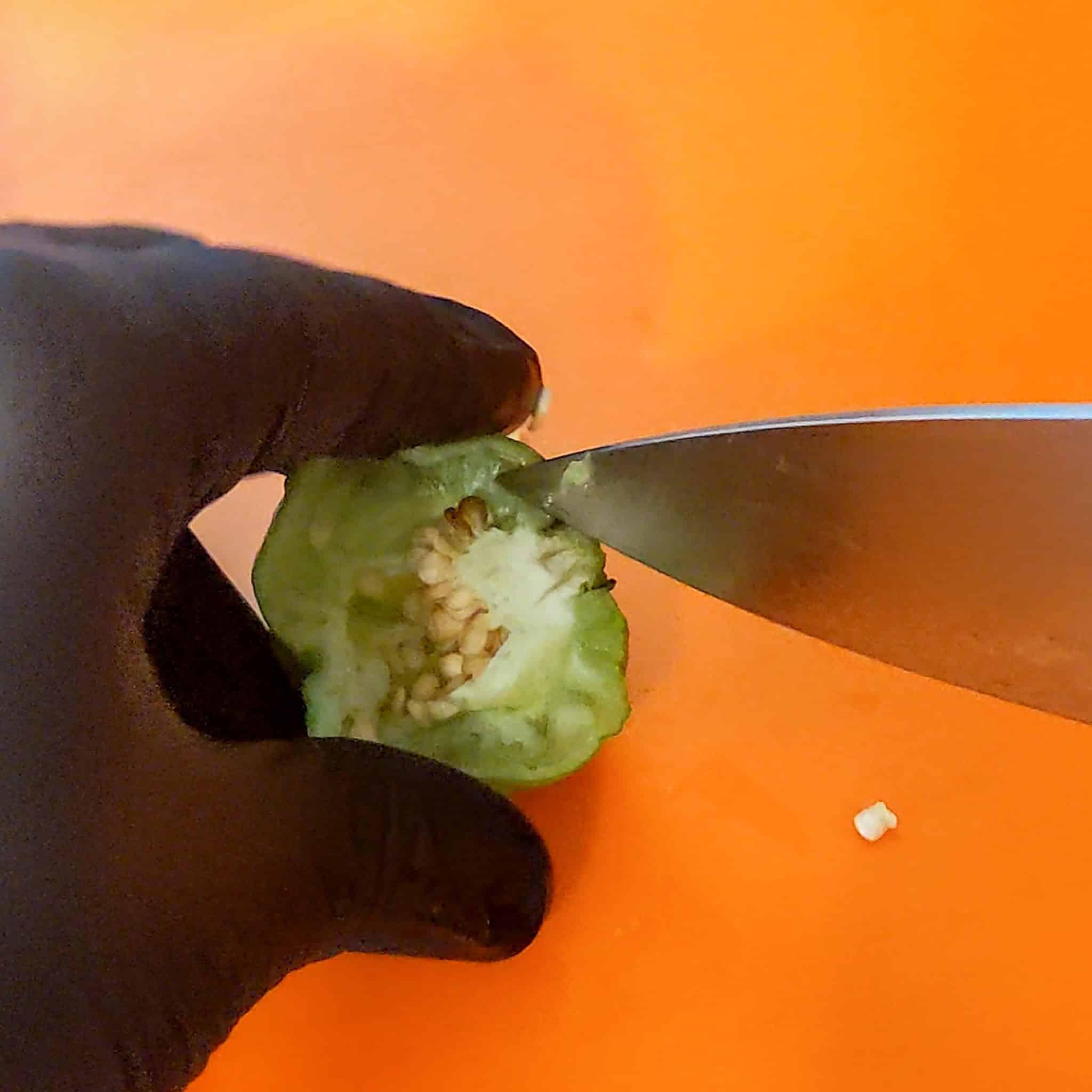
To reduce heat, you must remove the pith. Lay the pepper flat on the cutting board to prevent piercing fingers.
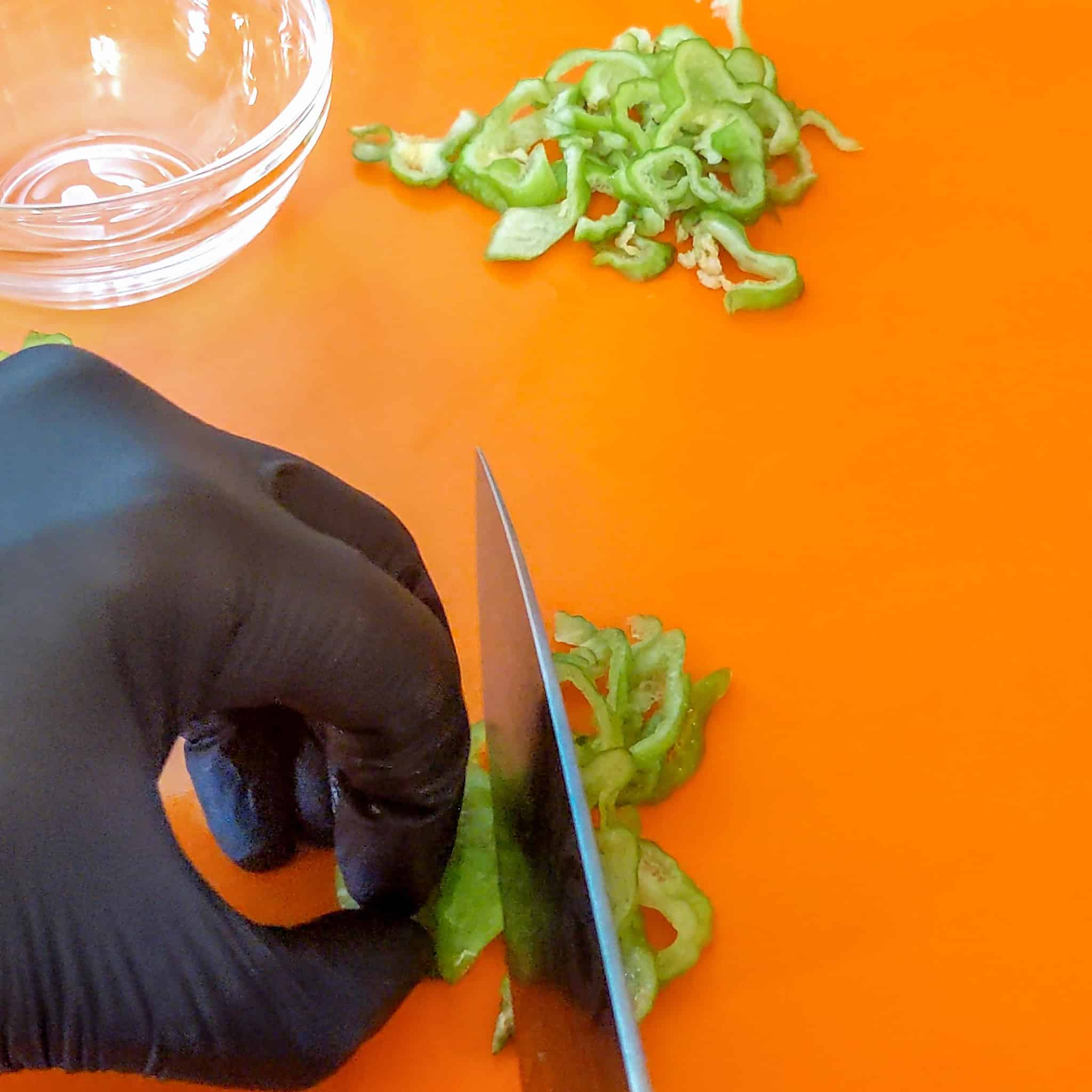
Make sure to use a sharp knife to slice it thinly with gloves on.
Substitutions
Dairy-Free
- Yay! This recipe is naturally dairy-free, so no substitutions are needed.
Gluten-Free
- Pasta - Use gluten-free pasta to make this dish suitable for those with gluten sensitivities.
Vegetarian
- Shrimp - To make this dish vegetarian, replace the shrimp with sautéed mushrooms or eggplant, which will absorb the spicy tomato sauce beautifully and add a meaty texture to the dish. This adaptation maintains the bold flavors and provides a hearty, satisfying meal.
Convenience
- Chopped Onion and Garlic - Use a food processor or chopper to prep these ingredients conveniently.
- Thyme - Substitute fresh thyme with dried thyme; use one-third of the amount called for in the recipe, as dried herbs have a more concentrated flavor.
- Fresh Chopped Parsley - Just like the thyme, use dried parsley to replace the fresh ingredient.
- Adobo seasoning - Make your own blend with garlic powder, onion powder, and paprika. Learn more about the use of adobo seasoning in the Latino community here.
- Scotch Bonnet Peper/ Chilies - Replace with jalapeños or red pepper flakes for a milder heat, or use serrano, habanero, or red pepper flakes for a similar heat level.
- Crushed Fire-Roasted Tomatoes - Use tomato paste or a basic pasta sauce; if the acidity is higher, cook the tomato ingredient enough to remove most of it.
- Pasta - Use your favorite pasta cooked to al dente as the packaging instructs.
Change Heat Level - Modify the recipe's heat level to your liking and learn more about the Scoville Scale and Chili Pairings.
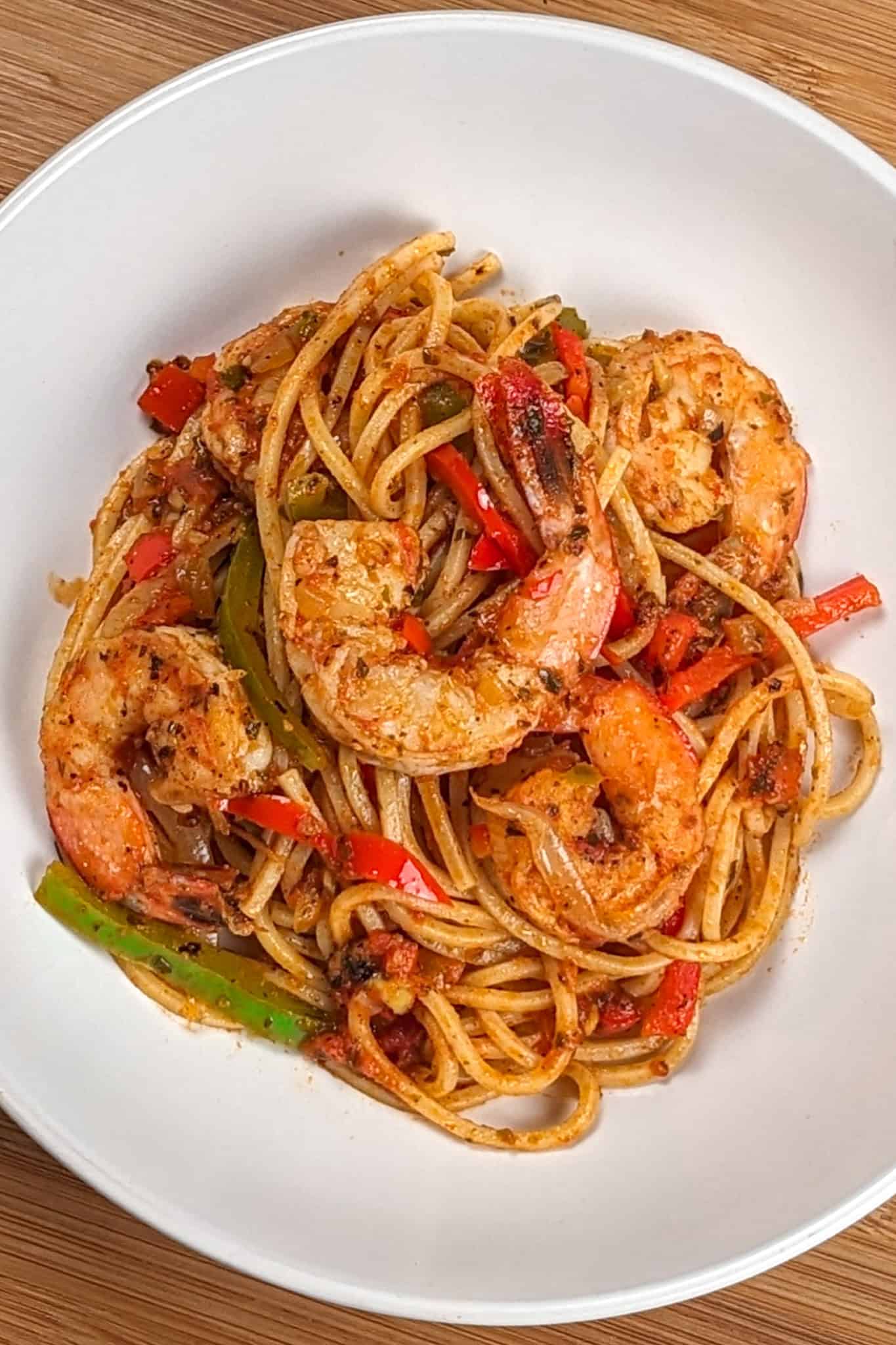
Variations
- Hot Dog - Replace shrimp with sliced hot dogs for a traditional Haitian touch, used in traditional Haitian-style spaghetti.
- Smoked Sausage - Use smoked sausage for a rich, smoky flavor that complements the sauce.
- Herring - Substitute shrimp with smoked herring for a unique, savory twist, traditionally used with Haitian spaghetti. (My fave!)
- Chicken - Use diced chicken breast or thighs for a lean protein option.
- Beef Steak Bites - Replace shrimp with tender beef steak bites for a hearty, meaty version.
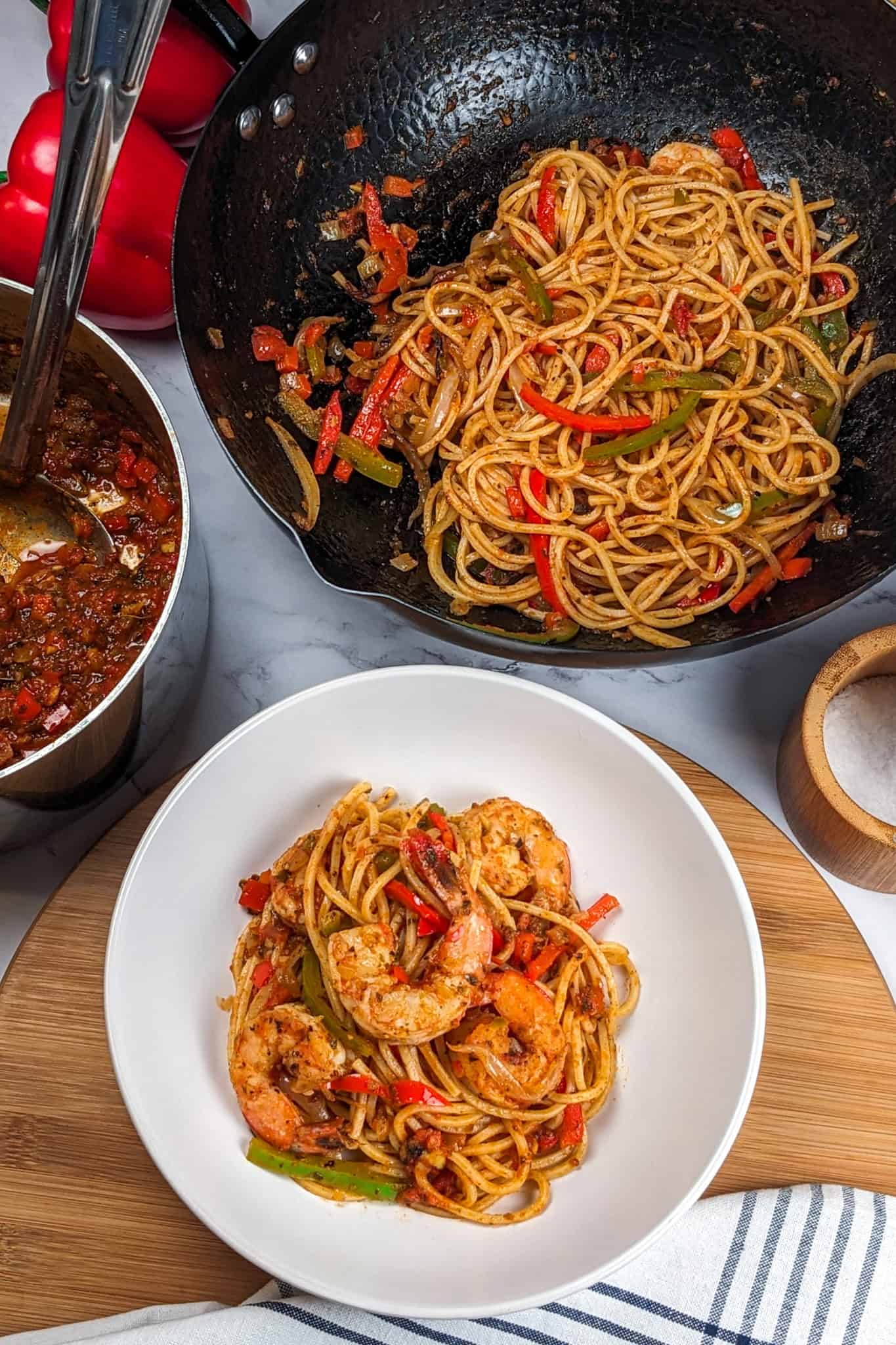
Equipment
- Large Saucepan - Used to prepare the spicy tomato sauce, allowing ingredients to meld and flavors to develop. I used the All-Clad D3 3-Ply Stainless Steel Sauce Pan.
- Pot - Boils the pasta, cooking it to al dente perfection.
- Paper Towels - Pat dry the shrimp, ensuring a good sear when cooking.
- Large Skillet or Wok - Sear the shrimp and cook the vegetables, providing quick and even heat. I used my 12.5" Carbon Steel Flat-Bottom Wok – perfect for the kitchen stovetop.
- Ladle and Spatula - Aids in adding the right amount of Creole sauce to the shrimp and pasta mixture when measuring, scooping it to add to the pasta and stir-frying. I used Wok Cooking Utensils.
My Rating: ⭐⭐⭐⭐⭐
Purchased: July 12, 2022
My Review: The BIELMEIER 12.5" Carbon Steel Wok is hands down my favorite wok to cook with. The size is perfect—not too big, not too small—and the flat bottom makes it super easy to use on any stovetop, especially for stir-fries and high-heat cooking. I was also impressed by the thoughtful design and the sleek packaging, which honestly makes it a great gift for anyone who loves to cook. What really stood out was the thorough set of instructions included on how to season and care for the wok—perfect for novice wok users who might feel intimidated. It’s a beautiful, functional piece that’s earned its permanent spot in my kitchen. Read my article on how to use a wok here.
Kitchen Must Haves - Find other tools I use here.
Storage
- Refrigerator - To store in the fridge, place it in a shallow 2-inch container to cool down quickly. Then, store it in an airtight container. The meal will last up to three days due to the shrimp.
- Freezer - Follow the refrigeration process mentioned above. Then, place it in the freezer in a labeled, airtight container. Freezing cooked spaghetti can be a little tricky since the moisture within the noodles will expand as it freezes, changing the texture of the pasta and making it mushy. Because of this, I do not recommend freezing this dish.
Airtight Food Containers
I interchange glass food storage containers with plastic clipping lids or wooden push-ins. I always suggest glass storage containers because they can be microwaved, they hold food without staining, and the glass keeps the food at a more stable temperature, keeping it fresher and longer.
Try the OXO Good Grips Smart Seal Glass Rectangle Food Storage Containers or the Pyrex Freshlock Glass Food Storage Containers.
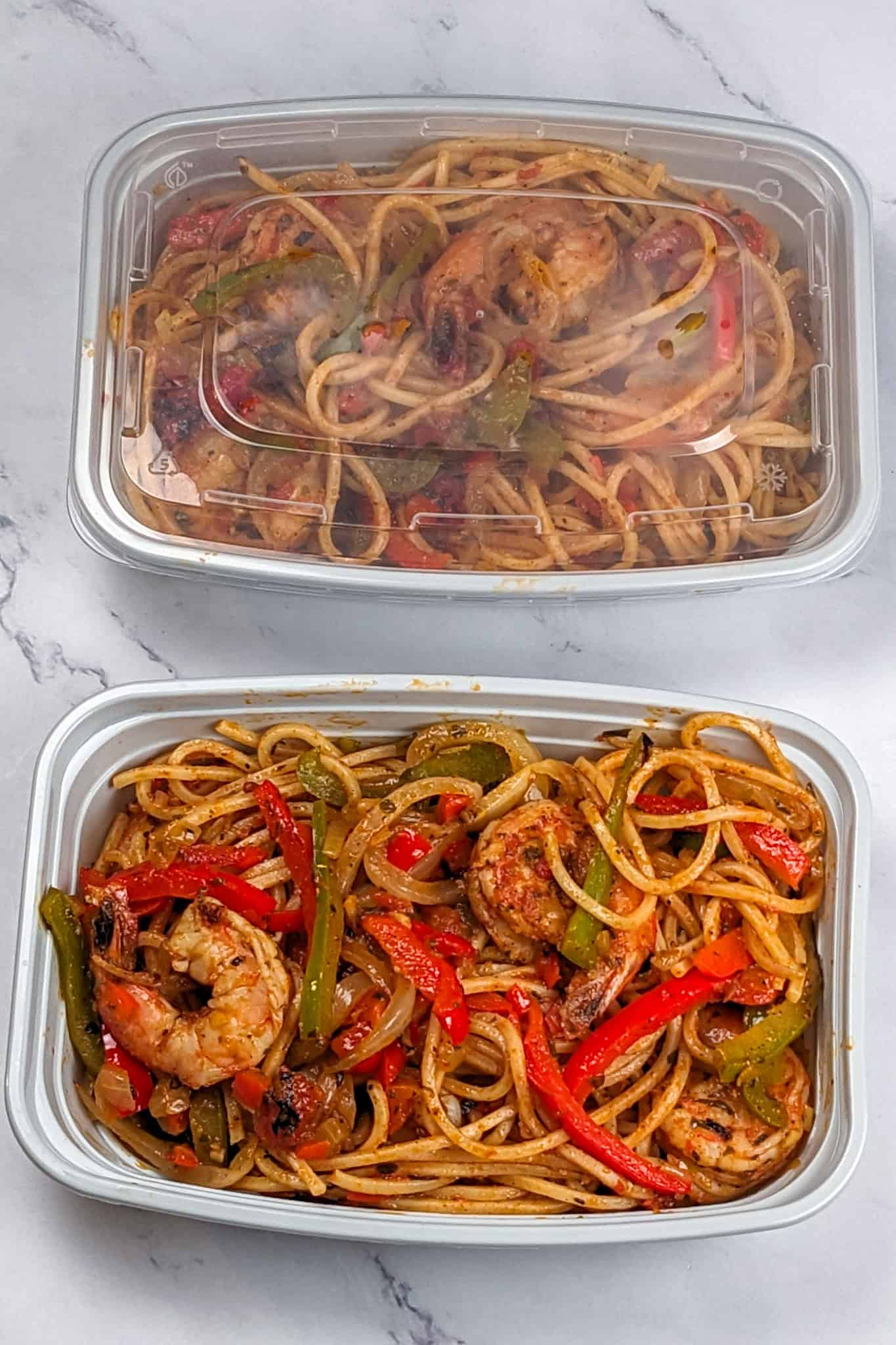
Cooking Tips
Your Cooking Tips Resource Guide - Become a better home cook with tips to help you cook more efficiently on the Cook's Notebook tab. Using a Wok - Since I used a wok to make this recipe, here are some helpful tips to remember when stir-frying. Learn more helpful tips about using a wok here.
- Preheat the Wok: Ensure your wok is properly preheated before adding any ingredients to achieve a quick sear and prevent food from sticking.
- Cut Ingredients Evenly: Cut all ingredients into uniform sizes to ensure they cook evenly and at the same pace.
- Cook in Small Batches: Avoid overcrowding the wok by cooking in small batches, which helps maintain high heat and achieve better browning and texture.
Frequently Asked Questions
Yes, you can prepare the sauce and pasta ahead of time, then combine and heat just before serving for an easy weeknight meal.
This pasta pairs well with a side salad or garlic or Haitian bread and sliced fresh avocado, adding freshness and texture to the meal.
Use less scotch bonnet pepper or remove the seeds with pith (the white flesh) to lower the spiciness while maintaining flavor.
Absolutely! Feel free to use your favorite pasta shape, such as penne or linguine, to suit your preference.
The combination of juicy shrimp, flavorful sauce, and aromatic spices creates a dish that rivals any restaurant meal, making it ideal for impressing guests or enjoying a special night dining in.
Haitian-Inspired Recipes
Looking for other Haitian-inspired recipes like this? Try these:
- Bold and Easy Caribbean Cooking with Haitian Recipes
- Green Seasoning Recipe | Epis - Haitian Style
- Creamy Curry Chicken Gnocchi Soup | Caribbean Style
- One-Pot Curry Meatball Soup with Ground Turkey and Kale
Seafood Recipes
Looking for other seafood recipes like this? Try these:
- 20 Irresistible Fish Recipes
- Seared Snapper Spicy Creole Sauce and Roasted Vegetables
- Sesame Seed-Crusted Ahi Tuna with Spicy Sesame-Soy Sauce
- Grilled Shrimp Garlic Jalapeno Butter and Cilantro Lime Rice
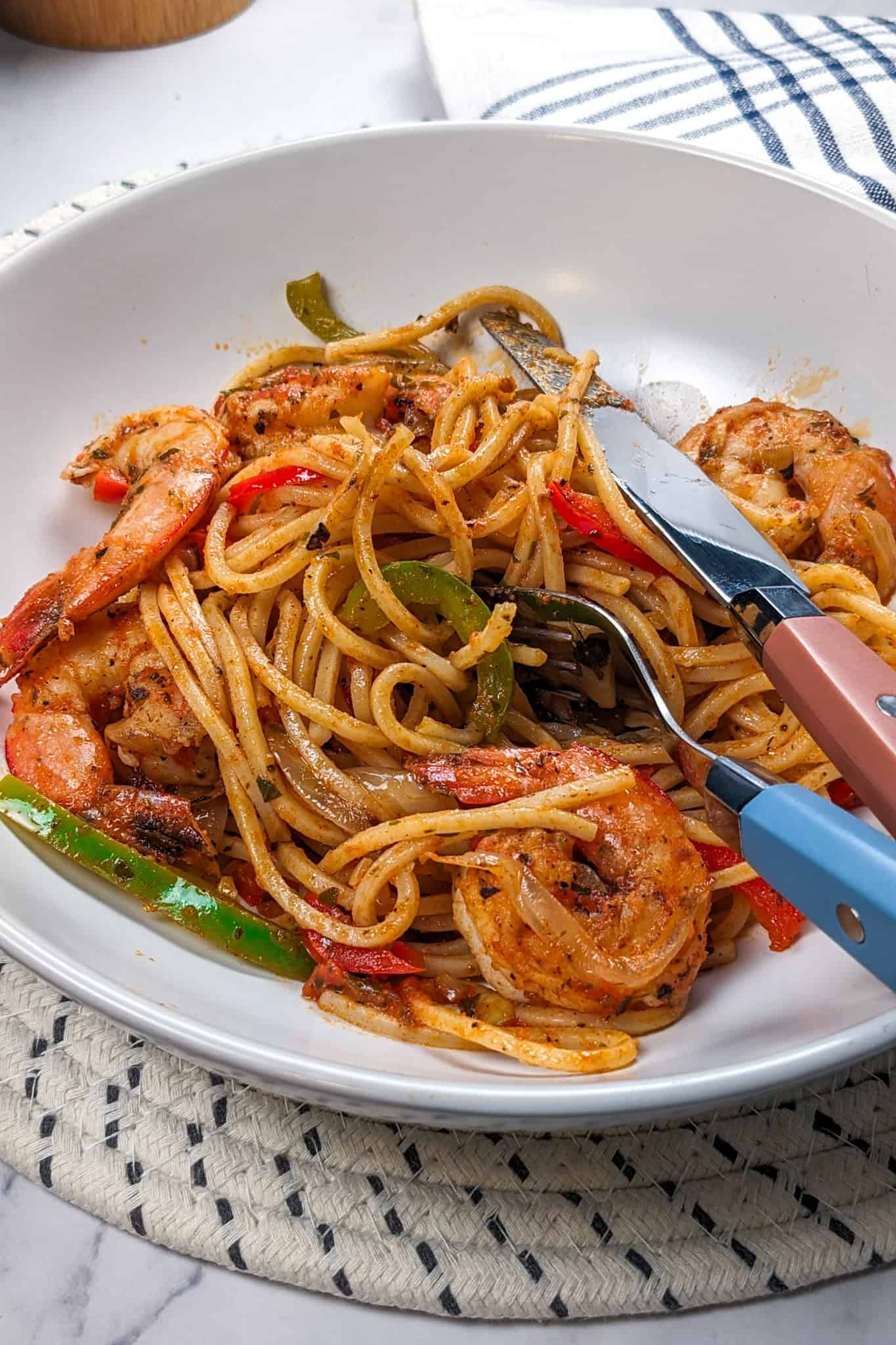
📖 Recipe
Healthy Haitian-Style Creole Spicy Shrimp Pasta
Ingredients
For the Creole Fire-Roasted Tomato Sauce
- 2 tablespoons olive oil
- 4 cloves garlic minced
- 1 medium onion finely chopped
- 1 teaspoon fresh thyme leaves
- ¼ teaspoon ground cloves
- 2 tablespoons fresh parsley chopped (plus extra for garnish)
- ½ bell pepper any color, finely chopped
- 1 scotch bonnet pepper finely chopped (seeds removed for less heat)
- 1 teaspoon adobo seasoning
- Salt and black pepper to taste
- 2 cups fire-roasted tomatoes canned or freshly roasted
- 1 cup chicken broth
For the Shrimp and Vegetables
- 1 pound jumbo shrimp peeled and deveined
- ½ white onion thinly sliced
- ½ red bell pepper thinly sliced
- ½ green bell pepper thinly sliced
- Juice of 1 lime divided
- ½ tablespoon olive oil for the pasta
For the Pasta
- 12 ounces pasta spaghetti or penne works well
Equipment
- Paper Towels
- Wok or large Saute Pan
Instructions
- Save time in the kitchen: Read the instructions thoroughly, then gather and prep all your ingredients before cooking! Learn Prepping Tips.
- Prepare the Sauce: Heat the olive oil over medium heat in a large saucepan. Add the minced garlic and chopped onions, and saute until fragrant and translucent, about 5 minutes. Then, stir in the thyme, ground cloves, parsley, finely chopped bell pepper, scotch bonnet pepper, adobo seasoning, salt, and black pepper.
- Combine and cook for another 3-4 minutes until the vegetables are softened. Then, add the fire-roasted tomatoes and chicken broth. Bring the mixture to a simmer. Let it cook for 15-20 minutes, stirring occasionally, until the sauce thickens slightly. While the sauce is cooking, cook the pasta.
- Prepare the Pasta: Cook the pasta in a pot according to the package instructions until al dente. (Note: To prevent overflow when boiling, lay a wooden spoon across the top of the pot.) Drain the pasta, spread it out on a sheet pan, mix it with ½ tablespoon of olive oil, set it aside, and let it cool. (Do not rinse the pasta). When the pasta has about 5 minutes left to cook, begin the shrimp and vegetables steps.
- Cook the Shrimp and Vegetables: (Note - Depending on the size of your skillet, you may have to do this per two servings to prevent overcrowding that can create a soggy dish.) Pat dry the shrimp with paper towels and season with salt and pepper. Heat a large skillet or wok on medium-high heat with olive oil. Then, sear the shrimp for about 2 to 3 minutes on each side, remove it, and set aside.
- Add the thinly sliced white onion, red bell pepper, and green bell pepper, and cook until slightly translucent for about 2 to 3 minutes. Next, add the shrimp back with a splash of lime juice (about half of the lime's juice) and stir to combine.
- Add a desirable ladle of the creole sauce and let the mixture simmer until the shrimp turn pink and opaque, about 3 to 4 minutes.
- Combine Shrimp, Sauce, and Pasta: Add the cooked pasta to the pan with the shrimp sauce. Toss everything together until the pasta is well coated with the sauce and evenly mixed with the shrimp and vegetables.
- Serve: Remove any visible fresh thyme stems. Then, plate the pasta and garnish with additional chopped parsley (optional).
Video
Nutrition
Subscribe to My YouTube Channel
SUBSCRIBE: 👈To my YouTube Channel to Get Notifications of New Videos.
Have a Comment or Question?
If you have a question or comment about this recipe, please post it below. You will definitely get a quick response. It also helps our other readers to stay informed. Thanks!

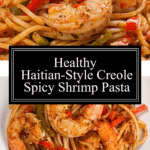
![My Everyday Lagos: Nigerian Cooking at Home and in the Diaspora [A Cookbook]](https://m.media-amazon.com/images/I/51CGRrW+dcL._SL500_.jpg)
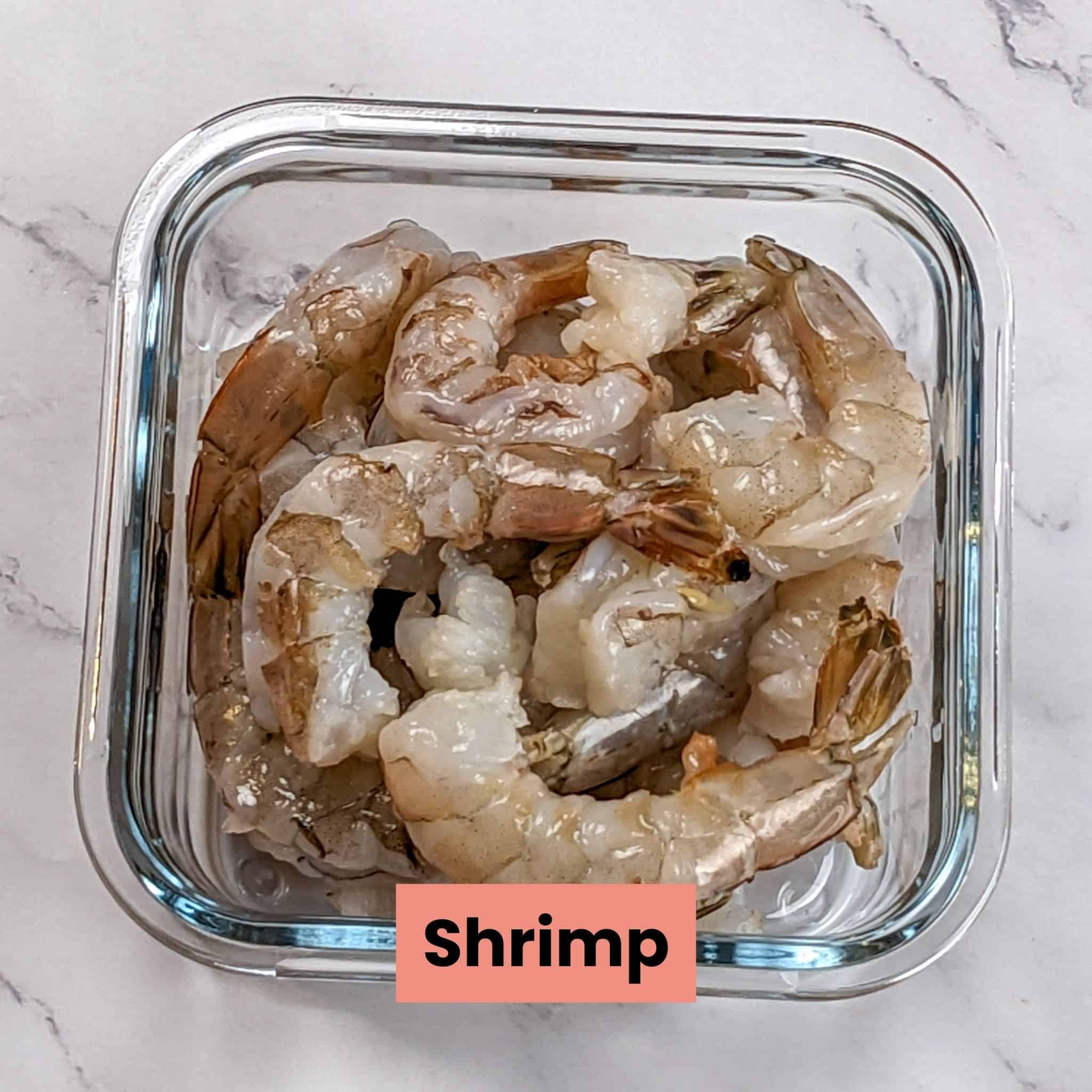
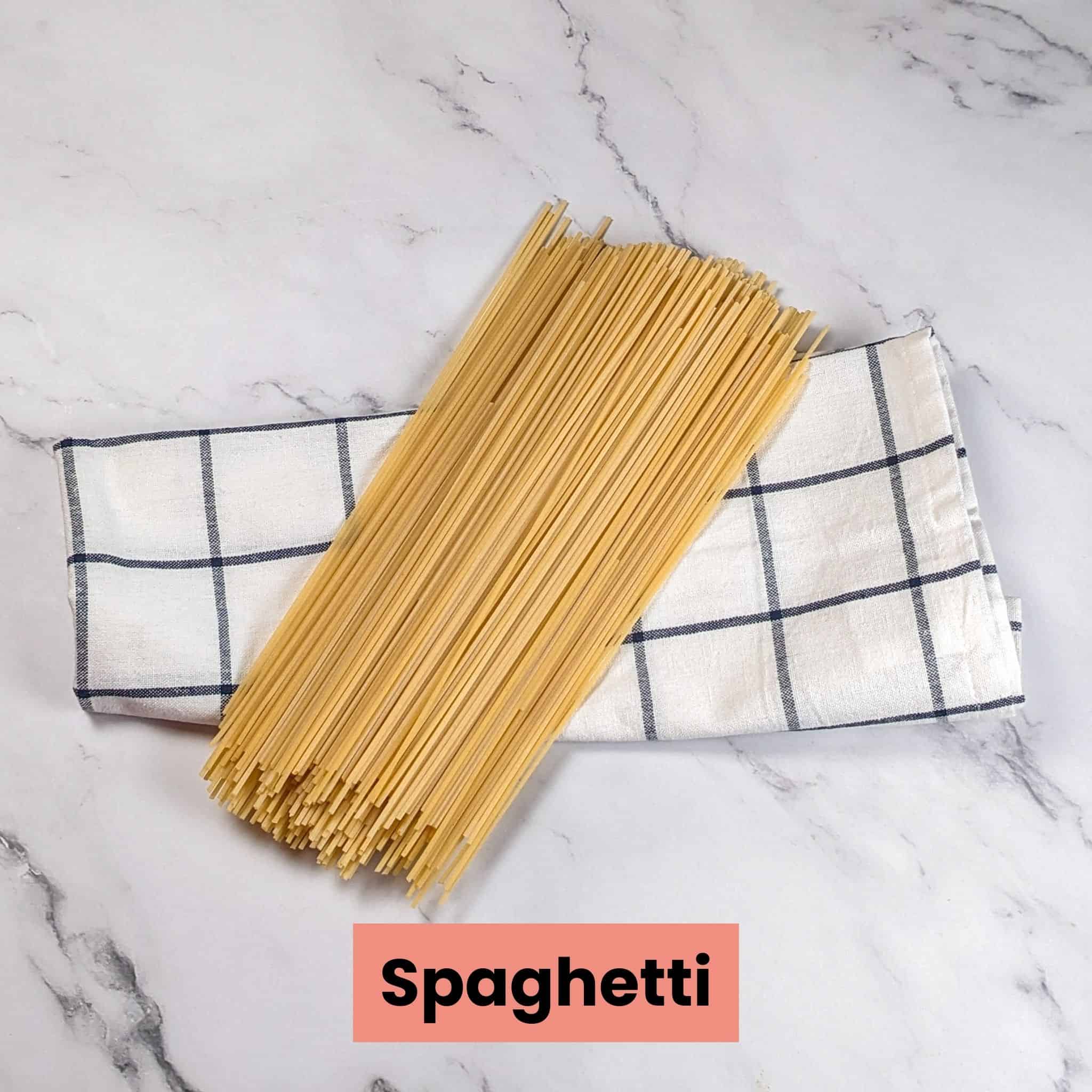
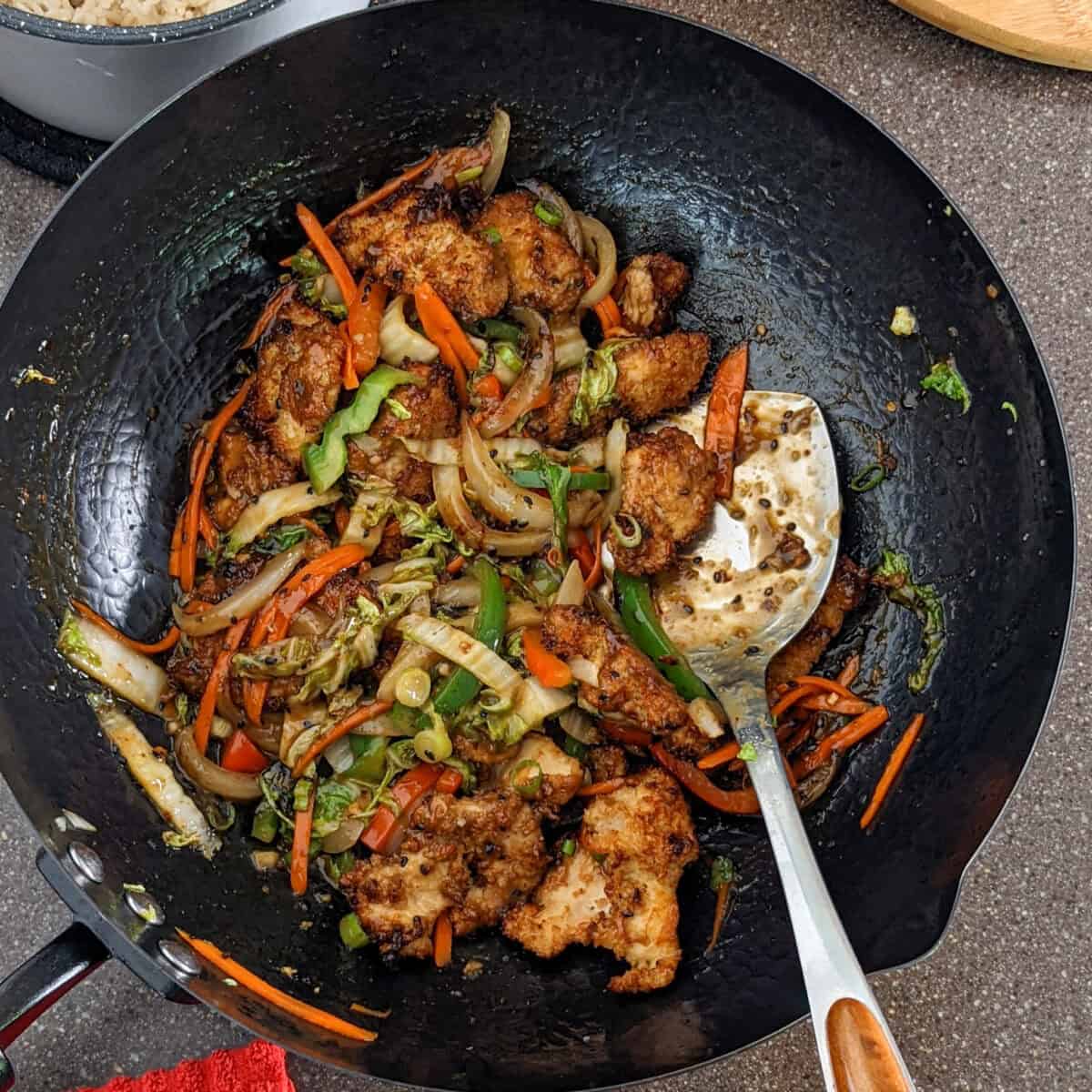
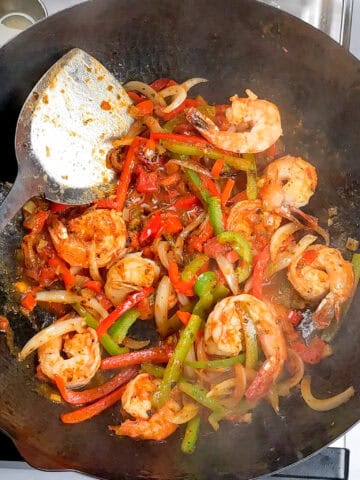
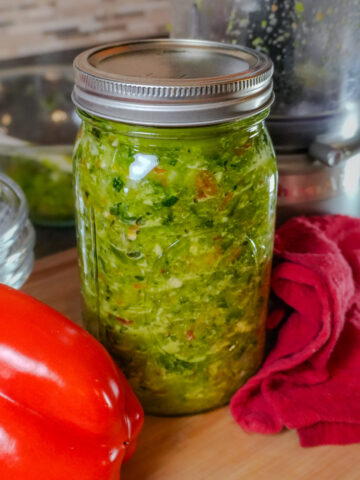
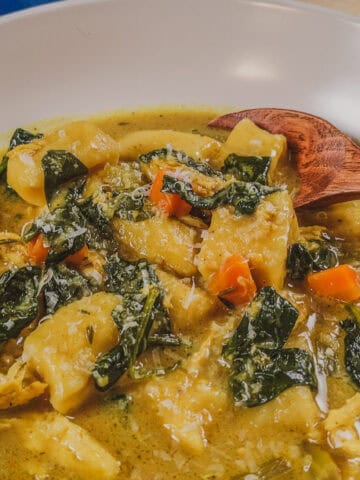
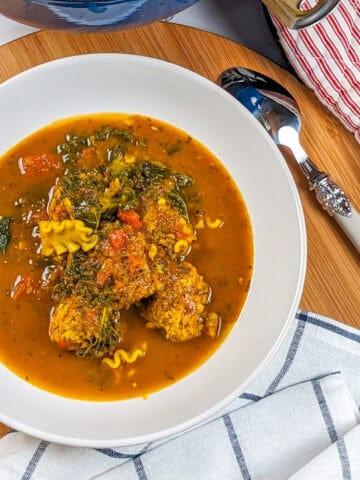
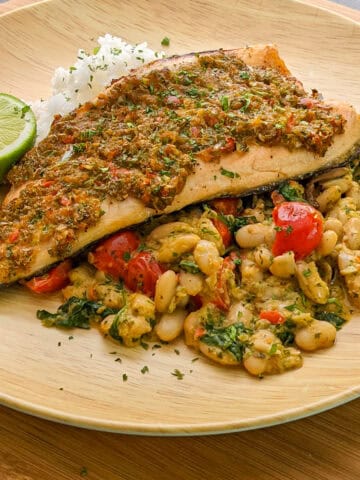
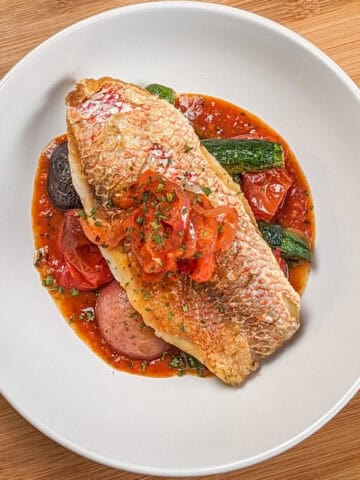
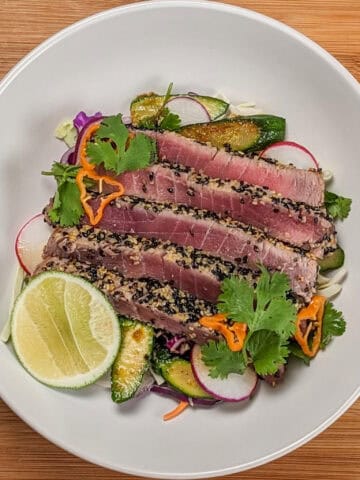
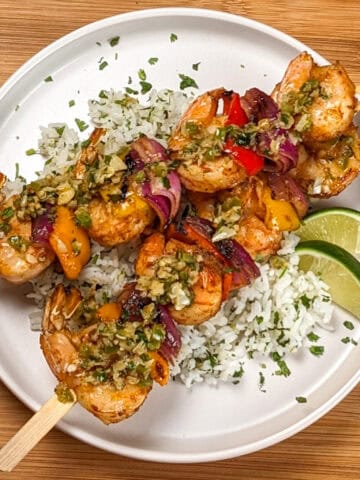
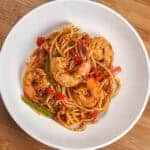
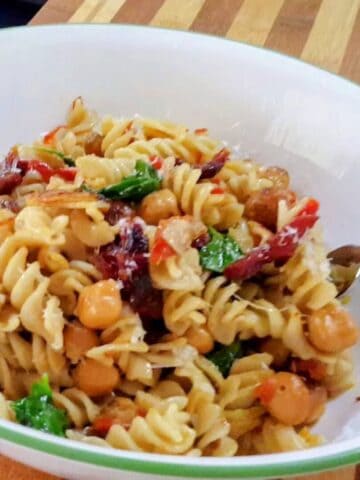
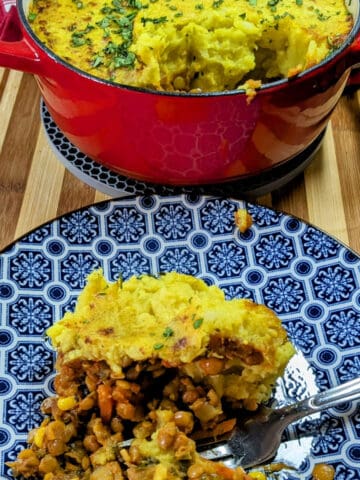
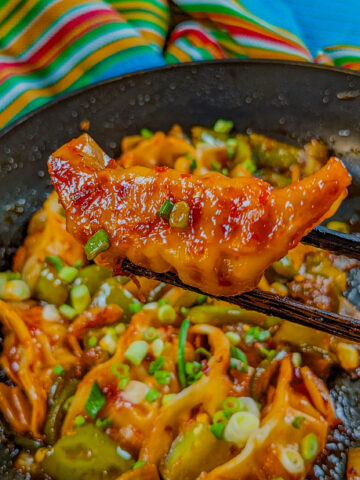
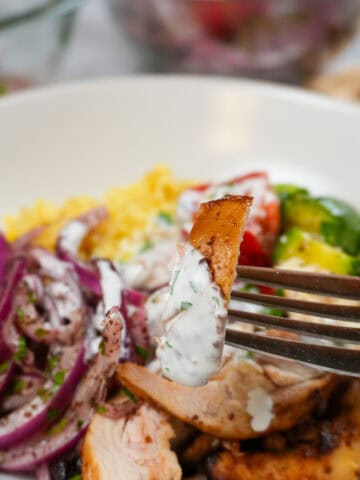
Leave a Reply